
Page 1 of 55
PUBLIC
RECOMMENDATION No 02/2023
OF THE EUROPEAN UNION AGENCY
FOR THE COOPERATION OF ENERGY REGULATORS
of 22 June 2023
on good practices for the treatment of the investment requests,
including Cross Border Cost Allocation requests,
for Projects of Common Interest
THE EUROPEAN UNION AGENCY FOR THE COOPERATION OF ENERGY
REGULATORS,
Having regard to Regulation (EU) 2019/942 of the European Parliament and of the Council of
5 June 2019 establishing a European Union Agency for the Cooperation of Energy Regulators
(ACER), and, in particular, Article 6(2) thereof,
Having regard to Regulation (EU) 2022/869 of the European Parliament and of the Council on
guidelines for trans-European energy infrastructure, and in particular, Article 16(11).
Having regard to the favourable opinion of the Board of Regulators of 16 June 2023, delivered
pursuant to Article 22(5) of Regulation (EU) 2019/942,
Whereas:
(1) Regulation (EU) 2022/869 of the European Parliament and of the Council of 30 May 2022
on guidelines for trans-European energy infrastructure (hereinafter also ‘TEN-E
Regulation’)
1
, provides for the identification of projects of common interest (hereinafter
also ‘PCIs’) and of projects of mutual interest (hereinafter also ‘PMIs’), which are
necessary to implement priority corridors and areas covering electricity transmission,
smart electricity grids, smart gas grids, hydrogen, electrolysers and carbon dioxide
2
.
1
OJ L 152, 3.6.2022, p. 45–102.
2
Article 1(2)(a) of Regulation (EU) No 2022/869.

PUBLIC
Recommendation No 02/2023
Page 2 of 55
(2) A net negative impact
3
affecting at least one country hosting
4
a PCI/PMI constitutes a
potential barrier to its development. As each PCI has an overall net positive impact at EU
level, it should generally be possible to provide compensation to eliminate the country-
specific net negative impact. Where possible, a harmonised approach should be applied
in order to identify the TSO or the project promoter which should provide such
compensation and those which should receive it.
(3) Regulation (EU) 2022/869 facilitates investments in PCIs/PMIs by envisaging decisions
by National Regulatory Authorities (hereinafter also ‘NRAs’) or by the European Union
Agency for the Cooperation of Energy Regulators (hereinafter ‘the Agency’) on the
allocation of the costs of such projects across borders if project promoters
5
submit an
investment request, including a request for a cross-border cost allocation (hereinafter also
‘CBCA’).
(4) In deciding on CBCA, NRAs should allocate efficiently incurred investment costs across
borders and include them in the national tariffs, and, afterwards, if relevant, determine
whether their impact on national tariffs could represent a disproportionate burden for
consumers in their respective Member States
6
.
(5) As soon as such a PCI or PMI has reached sufficient maturity and is estimated to be ready
to start the construction phase within the next 36 months, the project promoters, after
having consulted the TSOs from the Member States which are assessed as potentially
having a significant net positive impact from it, shall submit an investment request,
including a request for CBCA. That investment request could include a request proposal
for a cross-border cost allocation and shall be submitted to all the NRAs concerned.
(6) Article 16(4) of Regulation (EU) 2022/869 specifies the features of the investment
request to be submitted by project promoters. It requires that an investment request is
accompanied by a project specific cost benefit analysis (hereinafter also ‘CBA’)
consistent with the single sector methodologies drawn up pursuant to Article 11 of the
same Regulation. However, Article 16(4) does not specify the level of detail of the
information to be submitted by project promoters. A clarification of the details to be
submitted is essential to facilitate a consistent approach among project promoters and
NRAs for a given PCI or PMI. This should at the same time enable the submission of
complete investment requests of adequate quality and facilitate the minimisation of
delays.
(7) There is a time gap between the initial assessment of the positive impact of a project as
PCI/PMI and when the investment request is submitted. Within this period, the level of
3
See Section 2.4 this Recommendation about the term “net impact” and its calculation.
4
For the purpose of this Recommendation, “hosting country” is a country where the project is territorially located.
5
The term “project promoters” in this Recommendation applies also to the cases of PCIs/PMIs with one project
promoter.
6
Recital (47) of Regulation (EU) 2022/869.

PUBLIC
Recommendation No 02/2023
Page 3 of 55
maturity of the project as well as various elements of the assessment framework have the
potential to undergo modifications, which could consequently affect the costs and
benefits associated with the project.
(8) Because of the importance of the cross-border cost allocation process for advancing
infrastructure projects of EU-wide relevance, identification of good practices for NRAs
is of utmost importance to facilitate a proper treatment of the investment requests.
Experience with decisions on investment requests showed that the identification of
expected costs and expected benefits (and of robust scenarios for which benefits are
calculated) proved to be complex over the last years.
(9) In particular, concerning the assumptions underlying the project benefits, their
assessment is based on scenarios which depict potential paths that energy demand and
supply may take in the future. These scenarios are not predictions and, as such, the
societal and financial consequences of a project's implementation will always carry a
level of uncertainty. Additionally, different scenarios may even lead to opposite outcomes
when evaluating the project's cost-benefit analysis.
(10) The latest Agency’s Monitoring Report on CBCAs
7
reveals that, since 2013, there have
been 45 decisions regarding CBCAs, covering over 40% of the eligible current PCIs
(electricity and gas) and an approximate total investment cost of 16.5 billion euro. Given
the expansion of the CBCA instrument to include also new project categories and the
growing integration of the energy system across Europe, the importance of CBCAs is
expected to increase in the future. The Agency’s monitoring report also shows that the
majority of CBCA decisions taken since 2013 foresee that the hosting countries will bear
the costs of the projects based on the “territorial principle”
8
while less than 30% of
decisions deviate from this “traditional principle” and set cross-border payments.
(11) In this context, the Agency already issued its Recommendation No 07/2013 regarding the
cross-border cost allocation requests submitted in the framework of the first Union list of
electricity and gas PCIs. It revised the document in its Recommendation No 05/2015 in
the light of the experience gained with the assessment of the investment requests for the
PCIs included in the first Union list and the related decision
9
. The current
Recommendation, pursuant to Article 16(11) of Regulation (EU) 2022/869 and as
foreseen in the Agency’s Single Programming Document 2023-2025
10
, builds upon the
previous Agency’s recommendations, the results of the extensive public consultation, the
7
https://www.acer.europa.eu/Official_documents/Acts_of_the_Agency/Publication/2020-09_4th-ACER-
CBCA-report.pdf
8
I.e. without any cross-border financial contributions involved.
9
As summarised in the accompanying summary report “Experience with Cross-Border Cost Allocation,
September 2015” and forthcoming reports [https://www.acer.europa.eu/gas/infrastructure/ten-e/cross-border-
cost-allocation]
10
European Union Agency for the Cooperation of Energy Regulators Single Programming Document 2023-2025
p. 61-62; ACER_Programming_Document_2023-2025.pdf (europa.eu)

PUBLIC
Recommendation No 02/2023
Page 4 of 55
past experience with CBCA decisions as well as taking into account the new legal
provisions,
HAS ADOPTED THIS RECOMMENDATION:

PUBLIC
Recommendation No 02/2023
Page 5 of 55
1. INTRODUCTION AND SCOPE OF THIS RECOMMENDATION
Article 16 of Regulation (EU) 2022/869 applies to Projects of Common Interest and Projects
of Mutual Interest falling under the energy infrastructure categories of electricity
infrastructures
11
, hydrogen infrastructures
12
and smart gas grid infrastructures
13
, as long as
these projects fall under the competence of National Regulatory Authorities.
The Agency Recommendation No 05/2015, which was originally published on 18 December
2015, has been revisited in line with the provisions stated in Regulation (EU) 2022/869.
The aim of this Recommendation is to define good practices for the preparation, submission
and treatment of investment requests. This Recommendation is composed of a set of general
guidelines and good practices which can be applied to any infrastructure category, plus specific
section for specific project categories where adequate maturity of the current methodologies
and regulatory practices already exist.
For this reason, this Recommendation is addressed to project promoters submitting an
investment request, which includes a request for cross-border cost allocation, as well as to
National Regulatory Authorities seeking agreement on such requests.
This Recommendation does not apply to investment requests already submitted by project
promoters to NRAs before the date of its publication.
This Recommendation will be regularly updated in accordance with Article 16(11) of
Regulation (EU) 2022/869 and in light of the experiences gained with the future CBCAs.
11
Cf. Annex II (1)(a)-(f) of Regulation (EU) 2022/869.
12
Cf. Annex II (3) of Regulation (EU) 2022/869.
13
Cf. Annex II (2) of Regulation (EU) 2022/869.

PUBLIC
Recommendation No 02/2023
Page 6 of 55
2. ON THE PREPARATION AND SUBMISSION OF AN INVESTMENT REQUEST
This section covers the main elements to be considered when preparing an investment request
(and potentially a CBCA proposal). It provides indications to project promoters on how to
submit an investment request to the concerned NRAs, as well as on the information to be
included as part of the submitted investment request.
Identification of the subject of the investment request
As part of the submitted investment request, project promoters should clearly identify which
are the PCIs/PMIs and the related investment items
14
subject of the investment request. Project
promoters should also indicate the PCI/PMI identification code the project(s) refers to.
In certain situations, developing a PCI/PMI may have a significant impact for other PCIs/PMIs,
i.e. in case of complementary or competing projects.
Projects may be considered complementary if the aggregated benefits of a joint development
of the relevant PCIs/PMIs are higher than the sum of projects’ benefits estimated on a stand-
alone basis for each project.
Project promoters should always aim at identifying significant complementarities between
projects, discuss them with the relevant TSOs and aim at preparing joint analyses. In case of
significant complementarities with other PCIs/PMIs, project promoters should submit joint
investment requests.
The clustering of complementary PCIs/PMIs as part of the assessment carried out by the
Regional Groups should be considered by project promoters.
When clustering projects, project promoters should clearly identify, quantify and explain the
significant complementarities/dependencies of each project with the rest of the cluster. Where
the project cluster differs from the cluster published in the latest available Union list of
PCIs/PMIs, project promoters should include in the investment request an evaluation of the
differences between the original cluster and the chosen one, including a justification for
diverging from the original project cluster.
14
While there are no uniform definitions in the TEN-E, an investment item can be considered as the smallest set
of assets that together can be used to transmit electrical power and that effectively add transmission infrastructure
capacity. An example of an investment in the electricity is a new circuit and the necessary terminal equipment.

PUBLIC
Recommendation No 02/2023
Page 7 of 55
Also, when applying clustering, project promoters should adhere to the following general
principles:
a) projects should only be clustered together if they contribute significantly to the
realisation of the full potential of a main project
15
;
b) if no joint investment request for all complementary PCIs/PMIs is not submitted, the
individual investment requests should include references to the other complementary
projects, and should explain the dependencies and the reasons for separate processes;
c) all concerned projects need to have reached sufficient maturity (as per Section 2.3 of
this Recommendation).
In line with the above recommendations, for hybrid and multi-purpose projects
16
across
multiple countries, project promoters are encouraged to submit a shared cost-benefit analysis
and shared investment request, to ensure that the project accurately accounts for the impacts to
all countries involved, and that all sides are aligned in their approach, definitions and scope.
It is also important to note that a CBA provided for (any) cluster of projects only is not suitable
for deciding on a cross-border cost allocation. Therefore, the CBA accompanying the
investment request for complementary projects (see Annex I) should be completed by evidence
about the benefits and the necessity of each individual project.
Competing projects
Project promoters should aim at identifying any project competing with the projects subject of
the submitted investment request.
Competing projects are projects that fully or partially address the same identified infrastructure
gap or regional infrastructure need. Projects may be considered competing if the added value
of one project is significantly reduced by the presence of the other project (e.g. if they address
15
Projects that only marginally contribute to the realization of the full potential of a main project should not be
clustered together.
16
According to ENTSO-E TYNDP 2022 System Needs Study, hybrid projects are solutions that serve dual (or
even multi-) purposes such as the connection function of offshore RES to demand centres and by interconnecting
countries or bidding zones to facilitate trade, which then enables price convergence and indirect RES connection.
Hybrid interconnection projects are mainly expected offshore and are linked to the European Offshore RES
strategy but, in theory, onshore cases could also exist. The main difference between a radial interconnection and
a hybrid project or a multi-purpose interconnection is that the grid has a dual functionality combining electricity
interconnection between two or more Member States, and transportation of offshore renewable energy, to its sites
of consumption.
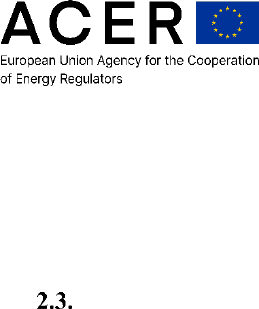
PUBLIC
Recommendation No 02/2023
Page 8 of 55
the same investment need, and the realisation of both of them would result in a lower overall
net impact than implementing only one).
Competing projects should always be identified and never be clustered together.
Sufficient Maturity
As soon as the project has reached sufficient maturity, and it is estimated to be ready to start
the construction phase within the next 36 months, Article 16(4) of Regulation (EU) 2022/869
allows project promoters to submit an investment request including a request for cross border
cost allocation.
In the Agency’s view, a “sufficiently mature” project is a project fulfilling all of the following
conditions:
a) sufficient certainty about the costs assessed by the project-specific CBA;
b) good knowledge of the factors affecting expected costs and their ranges;
c) as regards investment costs, a cost uncertainty range should be identified. The
maximum investment cost should not exceed the minimum investment cost by more
than 20%. If cost uncertainty is higher, the project promoters should illustrate the
underlying uncertainty factor(s) and justify why they do not adversely affect the
maturity of the project;
d) reasonable foresight of the benefits assessed by the project-specific CBA as described
in Annex I to this Recommendation;
e) reasonable knowledge of factors affecting benefits and their ranges, also with regard to
different scenarios and sensitivity analyses;
f) permitting procedures having started in all hosting countries. Where required, the
project promoters should already have notified in writing the project(s) to all competent
authorities of the Member States hosting the project(s), pursuant to Article 10(3) of
Regulation (EU) 2022/869, and the competent authorities should have acknowledged
in writing the notifications, confirming that they consider the project(s) mature enough
to enter the permit granting process;

PUBLIC
Recommendation No 02/2023
Page 9 of 55
g) commissioning to be achieved indicatively within 60 months from the date of
submission of the investment request
17
. If the expected commissioning date is beyond
such a period, project promoters should justify the underlying reason(s).
Calculation of national net impacts
Pursuant to Annex V(7) of Regulation (EU) 2022/869, the CBA Methodology used for the
CBCA shall ensure that the Member States on which the project has net positive impacts
(beneficiaries) and those Member States on which the project has a net negative impact (cost
bearers), which may be Member States other than those on which the infrastructure is
constructed, are identified. The Agency recommends that in addition to the Member States any
other significantly net impacted country is identified.
In the Agency’s view, for the identification of net beneficiary countries and net cost-bearers
countries, the calculation of the national net impact applicable to each of the countries
18
affected by the project should consist of three steps:
a) an analysis of the costs assessed by the project-specific CBA;
b) an analysis of the benefits assessed by the project-specific CBA;
c) an analysis of other cross-border monetary flows (as listed in Annex II to this
Recommendation).
The concept of “benefits” (which potentially include negative effects) is used to measure (in
monetary terms) all advantages (or disadvantages) of a project to society or to parts of society,
such as TSOs. Some – but not necessarily all - of the economic benefits (or negative effects)
can translate into cash flows. When this is not the case, they constitute externalities.
The first two steps described above are instrumental for a system-wide CBA (where monetary
flows across countries are neglected, because they offset each other), while the third step
completes the calculation with an analysis of how the cross-border monetary flows associated
with the project affect the net impact per country. If not already included in the benefits from
17
The timeline for the expected commissioning date may change depending on the complexity of the project.
According to the data collected through the Agency’s PCI monitoring exercise, the average duration for
completing a transmission project from the start of construction to commissioning is approximately 48 months.
When duly justified, NRAs might decide to extend the 60-months limit. To ensure that the evaluated benefits and
costs do not become excessively outdated, the Agency recommends limiting such extension to a maximum of 24
months.
18
Including non-Member States.

PUBLIC
Recommendation No 02/2023
Page 10 of 55
the system-wide CBA, these cross-border monetary flows may concern revenues or payments
related to capacity bookings, to Entry-Exit tariffs including surcharges resulting from auctions
in gas (or hydrogen), to congestion rents, to the ITC mechanism in electricity, to grants and to
other charges.
A country is a net beneficiary if the present value of the net benefit is positive.
A country is a net cost-bearer if the present value of the net benefit is negative.
For each concerned country, the calculation of the net impacts can be described by the
following formula.
Where,
• f is the first year where costs are incurred
• c is the first full year of operation of the project (or project cluster)
• x is the years considered for the assessment time horizon (see Annex I)
• y is the year of the analysis (i.e. the year of the submission of the investment request)
• r is the discount rate used to discount benefits and costs
• B are all the benefits assessed by the project-specific CBA
• F are all the benefits assessed in the analysis of other cross-border monetary flows
• C is the sum of costs (see Annex II)
The calculation of the national net impacts should avoid double-counting the effects.
Furthermore, national monetary transfers (e.g. payments of taxes and national grants) should
not be considered, as these are offset inside the respective country. The recognition of the
financing costs is dependent on the respective national regulatory systems
19
, but they should
not be counted as affecting the net impact per country. Potential grants (i.e. not already awarded
as of the date of the submission of the investment request) are not to be counted in the net
impacts calculation, but the project promoters should inform the NRAs of any potential grant
and notify them without delay if a grant is actually awarded thereafter.
19
Financing costs until commissioning of a project may be treated as investment costs under some regulatory
systems.

PUBLIC
Recommendation No 02/2023
Page 11 of 55
The choice of the scenarios for the calculation of net impacts
According to Article 16(4)(a) of Regulation (EU) 2022/869, as part of the investment request,
project promoters shall provide an up-to-date project-specific cost-benefit analysis by
considering at least the joint scenarios established by the European Network of Transmission
System Operators for Gas (hereinafter also ‘ENTSOG’) and the European Network of
Transmission System Operators for Electricity (hereinafter also ‘ENTSO-E’) for network
development planning. Where additional scenarios are used, those shall be consistent with the
Union’s 2030 targets for energy and climate and its 2050 climate neutrality objective and be
subject to the same level of consultation and scrutiny as the scenarios jointly developed for
network development planning.
Article 12 of Regulation 2022/869 requires the Agency to publish and regularly update
framework guidelines
20
for the joint scenarios to be developed by ENTSOG and ENTSO-E.
The Framework Guidelines establish criteria for a transparent, non-discriminatory and robust
development of scenarios and criteria to ensure their compliance with the energy efficiency
first principle and with the Union’s 2030 targets for energy and climate and its 2050 climate
neutrality objective.
In this respect, the Agency recommends that any additional scenario used by project promoters
for the project-specific cost-benefit analysis follow the principles and the criteria established
in the Agency’s Scenario Framework Guidelines.
When submitting the investment request to the NRAs, project promoters should provide a
thorough explanation of the reasoning behind the choice of any additional scenario. The project
promoters should also provide clear evidence of how the additional scenarios used and the
process to develop such scenarios, are compliant with the Agency’s Scenario Framework
Guidelines. When choosing additional scenarios, project promoters are also encouraged to take
into account the relevant Agency’s Opinions on scenarios and TYNDPs
21
.
20
https://www.acer.europa.eu/sites/default/files/documents/Official_documents/Acts_of_the_Agency/Framework_
Guidelines/Framework%20Guidelines/FG_For_Joint_TYNDP_Scenarios.pdf
21
E.g. the Agency’s Opinion on TYNDP 2022 scenarios is available at this link:
https://www.acer.europa.eu/sites/default/files/documents/Official_documents/Acts_of_the_Agency/Opinions/O
pinions/ACER%20Opinion%2006-2022%20on%20draft%20TYNDP%202022%20Scenario%20Report.pdf
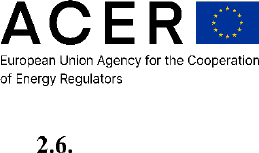
PUBLIC
Recommendation No 02/2023
Page 12 of 55
TSO consultation
Pursuant to Article 16(4) of Regulation (EU) 2022/869, prior to submitting an investment
request, project promoters should have duly consulted the TSOs from the Member States to
which the project provides a significant net positive impact. The assessment of the significant
net positive impact should be based on the project-specific CBA subsequently (potentially)
updated and submitted as part of the investment request. The Agency recommends that project
promoters also consult the TSO (if any) of each of the non-EU countries for which a significant
net positive impact is identified.
For the purpose of the consultation with the TSOs, the Agency recommends that all countries
above a specific significance threshold (see Section 3.9 of this Recommendation) should be
deemed as being subject to a significant net positive impact by the project. In the Agency’s
view, all TSOs of such countries (including non-Member States) should be consulted, in order
to favour adequate quality of the project-specific CBA.
In case of doubts concerning the presence of a "significant net positive impact" for a Member
State, the Agency recommends that project promoters consult also the TSOs of such a Member
State, so as to ensure that the consultation requirement established by Article 16(4) of
Regulation (EU) 2022/869 is fulfilled if the project turned out to provide a significant net
positive impact to such a Member State, as well as not to unduly hinder the decision-making
process.
The Agency recommends that the project promoters consult the TSOs of the concerned
countries to which the project provides a significant net positive impact also on the project
promoters’ CBCA proposal, if any, based on the net positive impacts identified by the project
promoters.
The consultation requirement, should be considered as fulfilled, if the consultation meets all
the following conditions:
a) the project promoters have formally informed the TSOs of the Member States to which
the project provides a significant net positive impact that they are being consulted for
an investment request under Article 16 of Regulation (EU) 2022/869;
b) the project promoters have provided the TSOs with a detailed technical description of
the project and a project-specific CBA (including scenarios used, input data and
calculations) as well as a description of other cross-border monetary flows;
c) the project promoters have allowed the TSOs a sufficient period of time to evaluate and
provide written feedback to them on the robustness and plausibility of the scenarios
used as well as on the project-specific CBA. The sufficiency of the period of time for
consultation depends on a series of relevant factors, such as the complexity of the
project, the previous cooperation at European, regional and bilateral level and the

PUBLIC
Recommendation No 02/2023
Page 13 of 55
degree of previous knowledge of the project. The Agency recommends that the project
promoters strive for a consultation period lasting indicatively from 4 to 8 weeks;
d) after having provided to TSOs sufficient time to provide feedback and after having
accordingly adapted the net impacts calculation, the project promoters have provided
the TSOs with a detailed description of how the provided feedback was considered (or
the reason why they were not considered) in the updated project-specific CBA;
e) the project promoters have ensured appropriate coordination, exchange of (potentially
different) views and a thorough discussion during and soon after the consultation period
in order to improve the project-specific CBA and, if any, the CBCA proposal, before
the submission of the investment request.
For the sake of facilitating the NRAs’ planning and later decision-making process, the Agency
recommends that project promoters inform the NRAs of the Member States whose TSOs are
consulted and provide them with the consultation documents, as soon as those are distributed
to or received from the TSOs.
Addressees and language of the investment request
The Agency recommends that project promoters address the investment request to the NRAs
of:
a) the Member State(s) hosting the project; and
b) any other Member State(s) having a potentially significant overall net positive impact
based on the project-specific CBA (i.e. the NRAs of the Member States whose TSOs
should be consulted by the project promoters).
The investment request and the accompanying documents should be submitted:
a) in the official languages of the addressed NRAs, if so required by the law of the
respective Member State; and
b) in English, being the internal working language of the Agency
22
.
22
Decision AB No 15/2014 of the Administrative Board of the European Union Agency for Cooperation of
Energy Regulators of 18 December 2014 on the internal language regime of the European Union Agency for the
Cooperation of Energy Regulators.

PUBLIC
Recommendation No 02/2023
Page 14 of 55
Information to be provided with the investment request
The Agency recommends that an investment request submitted by project promoters provides
the following information and, where appropriate, supporting evidence (in electronic form and,
where required at national level, in hard copy):
a) a detailed technical description of the project, including a description of the rationale
behind the choice of the technology, and a map of the planned route of the project in
case of transmission projects;
b) a detailed implementation plan of the project, which should provide substantial
information about the progress achieved in the development of the project and its status,
as well as a (probability) assessment of the critical and risk factors for the project and
the risk mitigation measures adopted in relation to those factors which could have the
most negative impact. The Agency recommends that, in the detailed implementation
plan, the project progress and status are described with reference to the main progress
steps in the development of the project, with an indication of the start and end dates for
each step. Dates could be either actual, as some of the steps will already have been
completed or expected. In line with the Agency’s infrastructure monitoring activities,
the following progress steps, which include the four stages outlined in Article 5(1) of
Regulation (EU) 2022/869, are identified in the development of projects of EU-wide
importance, and should be used as reference for the detailed implementation plan
23
:
i. under consideration: planning of studies (power flow and hydraulic simulations,
pre-feasibility and feasibility, including the techno-economic analysis of the
project) and consideration for inclusion in the national development plan(s)
(NDPs), regional plans and the TYNDPs of ENTSOG and of ENTSO-E;
ii. planning approval, but not yet in permitting: planning approval is the approval
(at the level of national development planning) by the NRA, by the competent
Ministry or by any other national competent authority, as foreseen in the
national law of each country. The planning approval may “start” with the
inclusion of the project in the draft NDP (e.g. release of the draft NPD,
submission to the NRA for approval, etc.) and “end” with the approval of the
NDP;
iii. preliminary design studies, which would include basic engineering design, etc.;
iv. environmental assessment, date of the request of the environmental assessment
and the (expected) approval date of the environmental assessment;
23
The steps are not strictly time-sequential, rather they usually partly overlap.

PUBLIC
Recommendation No 02/2023
Page 15 of 55
v. expected start and end dates of market test
24
(for gas and hydrogen PCIs/PMIs
only);
vi. preliminary investment decision
25
(if applicable);
vii. public consultation under Article 9(4) and 9(5) of Regulation (EU) 2022/869;
viii. permit granting process (including a pre-application procedure
26
and a statutory
permit granting procedure
27
when provisions of Chapter 3 of Regulation (EU)
2022/869) apply;
ix. expected start and end dates of cross-border cost allocation;
x. exemption from third party access (if applicable);
xi. expected date of the final investment decision
28
;
xii. expected start and end dates of detailed engineering design;
xiii. expected start and end dates of tendering (if foreseen), from call for tenders to
contract award(s);
xiv. expected start and end dates of construction;
xv. expected date of commissioning;
xvi. expected date on decision on the financing scheme.
c) a preliminary investment decision (e.g. a - possibly conditional - board decision on
intended investment), if applicable;
d) a short description of the status of the project permitting process in all hosting countries,
including a detailed schedule (in line with Article 10(6) and Annex VI(2) of Regulation
(EU) 2022/869) and corresponding evidence;
24
The market test is an open, transparent and non-discriminatory procedure which is carried out by the concerned
Transmission System Operator to assess the market demand through a non-binding phase where interested parties
may submit non-binding demand indications for new/incremental capacity, followed by a binding phase as a result
of which investment decisions are taken to proceed with the expansion of transmission infrastructure.
25
Please, see footnote 36.
26
The pre-application procedure start date is the date of signature of the acknowledgement by the competent
authority of the project promoter’s last notification.
27
The statutory procedure end date is the date of taking of the comprehensive decision pursuant to Article 10(1)
of Regulation (EU) No 2022/869.
28
According to Article 2(3) of Regulation (EC) 256/2014, “final investment decision” means the decision taken
at the level of an undertaking to definitively earmark funds for the investment phase of a project. It is therefore
the point in the project planning when the decision to make (major) financial commitment is taken.

PUBLIC
Recommendation No 02/2023
Page 16 of 55
e) information and evidence about the sufficient maturity of the project (see Section 2.3
of this Recommendation);
f) information on TSO consultations and the results of the consultations (see Section 2.6
of this Recommendation). The information should describe the documents shared, the
feedback (the elements on which TSOs agreed and did not agree and the reasons for
agreement/disagreement) of the consulted TSO(s), and explain in sufficient detail how
their comments were accepted and implemented or why they were rejected;
g) a project-specific CBA (see Annex I), consistent with the single sector energy system-
wide CBA methodologies drawn up pursuant to Article 11 of Regulation (EU)
2022/869, for all scenarios established for TYNDP and any other additional scenario.
The project-specific CBA should also include:
i. a sensitivity analysis and accompanying studies (for more details see Annex I
to this Recommendation);
ii. an assessment showing that the project fulfils a proven infrastructure need and
that no lower cost/impact alternative is available;
iii. a detailed assessment of the efficiency of the expected costs of the project,
including their comparison with unit investment costs or other information
(standard costs, historical costs) available at national, European or international
level and an explanation for any deviations;
iv. an analysis of the expected impact of the project on the Inter-TSO
Compensation (ITC) revenues and payments (for electricity PCIs/PMIs only);
v. an analysis of any other revenues/charges; and
vi. a summary of national net impacts for each country.
h) for the scenarios which are considered in addition to the ones developed for the
TYNDPs, a detailed explanation of the compliance with both European 2030 and 2050
targets, as well as with the Agency’s Scenario Framework Guidelines (see Section 2.5
of this Recommendation);
i) a business plan including a description of the chosen financing solution (including
tariffs), and information on grants and loans (awarded, applied for and expected), also
differentiating between national, European and other sources, as well as on the
estimated financing costs (indicating an estimation of the part of financing costs to be
incurred until commissioning of the project). In Members States where the tariff
calculation is carried out by TSOs, a description of the respective applicable national
methodologies for tariff calculation and of the project’s impact on network tariffs
should be provided in sufficient detail (for more details, see Annex III to this
Recommendation);
j) a substantiated proposal for cross-border cost allocation (if agreed by the project
promoters).
In addition, the Agency recommends that project promoters use a summary data template (only
in English) for submission of each investment request to the NRAs (see Annex IV to this
Recommendation).
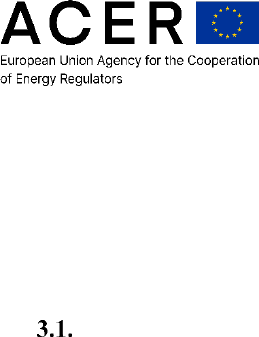
PUBLIC
Recommendation No 02/2023
Page 17 of 55
3. ON THE TREATMENT OF AN INVESTMENT REQUEST
This section provides guidelines to NRAs (and the Agency in case of acting as a residual
decision taker for a CBCA decision) on the elements to be considered when assessing project
promoters’ investments requests and cross-border cost allocation proposals.
Cooperation and coordination between NRAs
To ensure a timely and efficient treatment of an investment request, the NRAs receiving such
a request should jointly define a single “coordinating NRA”. The coordinating NRA should be
preliminarily identified as follows:
a) for projects situated in one Member State, the NRA of that Member State;
b) for cross-border projects, the NRA of the Member State in which the highest investment
costs are estimated based on the investment request submitted by the project promoters
to the concerned NRAs.
Unless otherwise required under national law, the coordinating NRA should:
a) serve as a single point of contact for project promoters and TSOs, while circulating all
documents to all other involved NRAs;
b) identify and collect NRAs’ needs for further information, and if necessary, request it
from the relevant parties (e.g. from project promoters and TSOs);
c) propose a process (timing, meetings, consultation, etc.) for NRA’s treatment of the
investment request and the drafting of an agreement on the investment request;
d) organise consultation of project promoters in cooperation with the other involved
NRAs, per Article 16(5) of Regulation (EU) 2022/869.
All involved NRAs should:
a) cooperate fully among themselves, in particular in relation to requests for further
information;
b) endeavour to meet any timeline or deadline agreed upon the proposal of the
coordinating NRA;
c) keep the other involved NRAs informed of progress on the timetable for delivering an
agreement on the investment request.

PUBLIC
Recommendation No 02/2023
Page 18 of 55
Treatment of complementary and competing projects
As mentioned in Section 2.1, project promoters should aim at identifying all relevant
interdependencies among projects, also with projects not subject of the investment request.
Before identifying the costs to be allocated, NRAs should evaluate whether all relevant
interdependencies have been considered by the project promoters when submitting the
investment request.
When competing projects are recognised by the NRAs, after receiving the investment request,
the Agency recommends that NRAs invite all project promoters of projects competing with the
one(s) for which the investment request was submitted, to provide their observations regarding
the investment request and any relevant information required by the NRAs on their projects to
make a well informed decision.
Completeness of the investment request
Given that the completeness of the investment request constitutes an essential element for
timely decisions, it is essential that an investment request includes all information listed in
Section 2.8 of this Recommendation.
The Agency recommends that NRAs conduct a preliminary assessment regarding the
completeness of the investment request, indicatively within one month of its receipt by the last
NRA. If the investment request lacks any of the required information listed in Section 2.8 of
this Recommendation, the Agency recommends that the NRAs jointly request, through the
coordinating NRA, the project promoters to provide the missing information within a
reasonable period of time, to be set on a case-by-case basis in relation to the volume and the
nature of the missing information.
The Agency recommends that, if the preliminary assessment reveals that some required
information has not been provided with the investment request, NRAs consider the date of
receipt of the last piece of missing information (to complete the required information as
specified in Section 2.8 of this Recommendation) by the last concerned NRA as the date of
receipt of the investment request pursuant to Article 16(5) of Regulation (EU) 2022/869 and
subsequently the start of the six-month period to take the coordinated cross-border cost
allocation decisions. If all requested data cannot be provided by the project promoters within
the given period of time, the investment request may be treated as incomplete. An incomplete
request should not lead to a cross-border cost allocation decisions.
In particular, when a cluster of PCIs/PMIs is the subject of the investment request (see Section
2.1 of this Recommendation), it is possible for NRAs to collectively decide to exclude one or
more projects from the cluster if the project promoters do not provide enough evidence of
complementarities. Conversely, NRAs can also collectively agree on the need to include
projects that were not originally part of the cluster but show complementarities with the

PUBLIC
Recommendation No 02/2023
Page 19 of 55
clustered projects. In both situations, NRAs should invite all relevant project promoters to
resubmit an investment request that includes all relevant complementary projects.
In addition to the information to be provided by project promoters in line with Section 2.8 of
this Recommendation, NRAs may jointly request additional information without effects on the
six-month period to take coordinated cross-border cost allocation decisions.
Quality of the information provided with the investment request
It is essential that an investment request is of an adequate quality to enable NRAs to take well-
informed and robust decisions. NRAs should assess the robustness of the scenario analysis and
the quality of the CBA submitted by project promoters.
The Agency recommends that, if the involved NRAs agree that the information provided by
the project promoters is not of adequate quality
29
and that, therefore, the investment request
needs to be updated with regard to certain elements, the coordinating NRA requests the project
promoters to provide the required information (i.e. update the investment request) accordingly,
and project promoters do so. Additionally, the Agency recommends that project promoters
propose an update of the information provided with the investment request in case
developments become known which have a substantial impact on the investment request.
An update of the investment request does not affect the six-month period to take coordinated
cross-border cost allocation decisions unless it is significant.
The Agency recommends that in case of a significant update of the investment request the six-
month period to take coordinated cross-border cost allocation decisions should start from the
date of receipt of the significant update by the last NRA, and thus be considered as the date of
receipt of the investment request pursuant to Article 16(5) of Regulation (EU) 2022/869. In the
Agency’s view, an update of the investment request should be considered as significant if it
reflects one or more of the following developments:
a) a significant variation in total costs (i.e. exceeding the cost uncertainty range identified
in Section 2.8 of this Recommendation);
b) a significant change in the national net impacts calculated in the project-specific CBA
such that the latter attributes a significant net impact to a Member State which was not
identified in the initial investment request;
c) a change in the project cluster composition initiated by project promoters or by NRAs;
29
E.g. the information is not correct, not accurate or misleading.

PUBLIC
Recommendation No 02/2023
Page 20 of 55
d) an update of the information provided with the investment request deemed to be
significant by all NRAs.
Identification of costs to be allocated
Article 16(1) of Regulation (EU) 2022/869 states that the efficiently incurred investment costs,
which exclude maintenance costs, shall be borne by the relevant TSOs (or the project
promoters) of the transmission infrastructure of the Member States to which the project
provides a net positive impact.
Whereas a project-specific CBA accompanying an investment request has to take into account
the total costs of a project
30
, the cross-border cost allocation decisions need only to consider
31
,
as a basis for the allocation, the “efficiently incurred” investment costs of the project subject
of the investment request.
Investment costs usually cover items related to the development, construction and
commissioning of projects, such as those listed in the first four rows of the table in Annex II
to this Recommendation. Replacement costs during the lifetime of the project are not to be
considered for cross-border cost allocation purposes.
Only investment costs which are related to the project(s) subject of the investment request, and
which are considered in the respective Regulatory Asset Base (hereinafter also ‘RAB’) are to
be included in the basis for cost allocation.
“Efficiently incurred” refers to two aspects:
a) the presence of an actual infrastructure need for the PCI(s) subject of the investment
request, as well as the absence or non-feasibility of any alternative project which would
be able to fulfil the same infrastructure need at a lower total cost. The infrastructure
need can be assessed by comparing the key features of the project (e.g. increase of
transmission capacity between zone A and zone B and unit cost expressed e.g. in
Meuro/MW) to the results of ‘infrastructure gaps/needs’ studies carried out at
European, regional or national level;
b) the comparison with the comparable costs of an efficient TSO. In fact, the more precise
level of the efficiently incurred investment costs can only be evaluated after the
realisation of the project. Therefore, a preliminary evaluation of expected efficient
investment costs should be conducted during the evaluation of an investment request
30
Cf. Annex V(8) of Regulation (EU) 2022/869.
31
Cf. Article 16(1) of Regulation (EU) 2022/869.

PUBLIC
Recommendation No 02/2023
Page 21 of 55
based on published (reference) values for unit investment costs
32
, historic costs, or
studies of the planned costs, taking into account the regulatory framework applicable
in each country. The outcome of the preliminary evaluation does not prejudice that an
evaluation of the efficiently incurred investment costs after the realisation of the
project is carried out in line with the legislative and regulatory framework applicable
in the relevant Member State.
In case of hybrid interconnection projects which include also investment in generation projects
(e.g. offshore wind generation), the NRAs, together with the project promoters, should be able
to identify the costs related to the generation assets separately from the costs related to the
transmission assets before allocating the relevant investment costs to the transmission projects,
the latter being the category eligible for CBCA under Article 16(1) and Article 16(2) of
Regulation (EU) 2022/869.
The evaluation of the scenarios in allocating costs across borders
Article 16(5) of Regulation 2022/869 states that in allocating costs across borders, the relevant
NRAs, after consulting the TSOs concerned, shall seek a mutual agreement based on, but not
limited to, the information specified by the project promoters in the submitted investment
request (see Section 2.5, Section 2.8 and Section 3.3 of this Recommendation).
According to the same Article, the NRAs’ assessment shall consider all scenarios jointly
developed by the ENTSOs for the TYNDPs and potentially other scenarios for network
development planning. Where additional scenarios are used, they shall be consistent with the
Union’s 2030 targets for energy and climate and its 2050 climate neutrality objective and be
subject to the same level of consultation and scrutiny as the process provided for the scenarios
jointly developed by the ENTSOs.
Scenarios depict potential paths that energy demand and supply may take in the future. These
scenarios are not predictions and, as such, the societal and financial consequences of a project's
implementation will always carry a level of uncertainty. Additionally, different scenarios may
even lead to opposite outcomes when evaluating the project's cost-benefit analysis.
The Agency’s Scenario Framework Guidelines adopted on 25 January 2023 request ENTSOG
and ENTSO-E to build a set of scenarios which shall include, at least, a best-estimate central
scenario (based on National Energy and Climate Plans, ‘NECPs’) and low-economy and high-
economy variants (as a stress test on network and project development).
32
According to Article 11(9) of Regulation (EU) 2022/869, every three years, the Agency shall establish and
publish a set of indicators and corresponding reference values for the comparison of unit investment costs for
comparable projects of the energy infrastructure categories included in Annex II of Regulation (EU) 2022/869.

PUBLIC
Recommendation No 02/2023
Page 22 of 55
In the Agency’s view, benefit results significantly depend on the input scenarios and related
assumptions. The quality of the scenarios used for project assessment is a critical element for
a robust allocation of costs among countries. Therefore, it is essential that NRAs consider
uncertainties, especially with regard to long-term scenarios, and take them into account when
taking decisions.
In line with Article 16(5) of Regulation (EU) 2022/869, the Agency recommends that the
involved NRAs, before taking a decision on how to allocate costs across-borders, duly assess
the project(s)’s costs and benefits from all scenarios used by the project promoter(s) in
accordance with Section 2.5 of this Recommendation.
The choice of the scenarios in allocating costs across borders
In line with the provisions of Regulation (EU) 2022/869, consideration of additional scenarios
to the ones developed according to Article 12 of Regulation (EU) 2022/869 can be necessary
to ensure proper robustness of the CBCA decision. For example, this could be the case when
certain drivers behind the evaluation of projects are more relevant at regional-level than at pan-
European-level, or when more updated information becomes available compared to when the
scenarios for TYNDPs were prepared or there are significant changes in some of the parameters
considered.
When considering additional scenarios (including those instances where the scenarios for
TYNDPs are updated for one or more input parameters) than the ones used by the project
promoter(s) for the submitted investment request, NRAs should provide an explanation of the
reasoning behind such choice. Within this framework, when allocating costs across borders,
NRAs could jointly agree to attribute different weights to the CBA results and identified
country impacts based on the different scenarios. The cross-border cost allocation decisions
should contain a thorough explanation of the reasoning behind the weights attributed to the
different impacts.
Without prejudice to the provisions in Article 16(4) regarding the use of scenarios for the
purpose of cross-border cost allocation, the Agency recommends that concerned NRAs agree
on how to take into account, for the purpose of consistent calculation of the benefits and of the
subsequent cross-border cost allocation, each robust and plausible scenario.
In case NRAs cannot agree on how to take into account each of the robust and plausible
scenarios for the purpose of consistent calculation of the country impacts and of the subsequent
cross-border cost allocation, the Agency recommends NRAs to base the decision on the
investment request and the cost allocation at least on the TYNDPs’ best-estimate central
scenario as defined in the Agency Scenario Framework Guidelines, as long as such scenario is
deemed robust and plausible by the concerned NRAs. If NRAs agree, they may base the
decision on additional robust and plausible scenarios.

PUBLIC
Recommendation No 02/2023
Page 23 of 55
The allocation of costs
The Agency is of the opinion that the following considerations should be taken into account:
a) Regulation (EU) 2022/869 aims at enabling investments with a cross-border impact;
b) any benefit analysis encompasses uncertainties with respect to the future benefits per
country, especially with respect to different scenarios and CBA indicators, and
c) a pragmatic and workable approach is needed in deciding on investment requests.
Therefore, unless NRAs agree otherwise, the Agency recommends that, once NRAs have
jointly agreed on the scenarios, compensations are provided if:
a) at least one Member State hosting the project has an overall net negative impact as per
Section 3.7, and;
b) each of the identified contributing countries has an overall net positive impact as per
Section 3.7.
In case the NRAs cannot agree on the level of compensation, the Agency recommends NRAs
to compensate the net negative impact in the relevant Member States, so that they become
neutral. Agreements that go beyond the compensation of the net negative impact, taking into
account the uncertainties in the analysis of benefits or unreasonably different net impacts across
Member States after cost allocation, are possible.
If the net negative impact is higher than the total amount of the expected efficient investment
costs
33
, the cross-border cost allocation decisions should compensate the net negative impact
up to the maximum amount of the expected efficient investment costs.
When deciding on cross-border cost allocation, in line with Article 16(5) of Regulation (EU)
2022/869
34
, NRAs should allocate 100% of the expected efficient investment costs in
accordance with calculation of national net impacts in Section 2.4 of this Recommendation and
with the principles explained in this Section.
33
This may be the case if a project has significant operational costs.
34
Recital (47) of Regulation 2022/869.

PUBLIC
Recommendation No 02/2023
Page 24 of 55
Significant threshold when allocating costs
In general, countries to which a project provides a net positive impact should provide
compensation. However, it is possible that not every expected net positive impact for a country
actually justifies that this country provides compensation. This may be the case where small
contributions would be required from a large number of countries, thus causing significant
negotiation and administrative costs. Involvement of countries with small net positive impacts
would unnecessarily increase the complexity of the procedure for the cross-border cost
allocation.
As Article 16(4) of Regulation (EU) 2022/869 states that an investment request shall be
submitted after the project promoters have consulted the TSOs from Member States
35
to which
the project provides a significant net positive impact, the Agency recommends that a
‘significance threshold’ is applied such that only countries with an overall net positive impact
exceeding the significance threshold provide compensation.
In this context, the significance threshold should be, in principle, equal to 10% of the sum of
net positive impacts accruing to all beneficiary countries.
The Agency recommends that, for the countries whose net positive impact exceeds the
significance threshold, the required compensation is allocated proportionally to the following
Compensation Indicator (CI): [overall net positive impact exceeding the significance threshold
for the country] / [sum of overall net positive impacts exceeding the significance threshold for
all countries whose overall net positive impacts exceed the significance threshold].
The CI ensures that the compensation is divided proportionally between the countries with
significant net positive impacts according to their shares of the overall net positive impacts
exceeding the significance threshold. For equal treatment of countries below and above the
threshold, the CI should be applied only to the absolute value corresponding to the overall net
positive impacts exceeding the significance threshold.
If the net positive impacts of the contributing Member States above the 10% significance
threshold are not sufficient to cover the compensation required, the significance threshold
should be lowered step-wise by 1% per step, until the sum of net positive impacts accruing to
all beneficiary Member States is sufficient to cover the required compensation.
NRAs may, upon joint agreement, apply a significance threshold that differs from the 10%
threshold defined above. Also, NRAs may, upon joint agreement, establish a minimum
significance threshold to limit the step-wise reduction or take other appropriate measures. This
35
In line with Section 2.6, this Recommendation suggests that project promoters also consult the TSO of each of
the non-EU countries for which a significant net positive impact is identified.

PUBLIC
Recommendation No 02/2023
Page 25 of 55
might be particularly relevant in cases in which the significance threshold leads, in terms of
contribution/cost allocation, to unreasonable results or to an excessive fragmentation across
Member States and/or in the case the uncertainties associated to the CBA benefits justifies it.
If a minimum significance threshold is considered, in line with its previous Recommendation,
the Agency recommends a minimum significance threshold of 5%.
Treatment of uncertainties and mechanisms for the adjustments of the cost
allocation
Uncertainty can describe a situation where the outcome of an event or of a decision is not
(completely) known, and the probability of different outcomes is unclear or unpredictable.
To facilitate the implementation of PCIs/PMIs, a stable and predictable regulatory framework
is key for legal certainty and clarity for all involved parties.
Cross-border cost allocation decisions should clearly specify ex-ante the conditions and terms
under which pre-defined adjustments of the cost allocation should be implemented after the
commissioning of the project. The Agency therefore recommends that all mechanisms to deal
with uncertainty should be agreed ex-ante in the CBCA decision.
To achieve this, when preparing and evaluating a CBCA request, it is necessary to address
uncertainties which concern at least:
a) the scenarios used and the related assumptions;
b) the benefits delivered by the actual availability of the infrastructure and the input used
to monetise those benefits;
c) the variation in the investment cost estimates;
d) future public funding.
While some adjustment may be useful to foresee, NRAs should aim at limiting the number of
cases and the complexity of adjustment payments.
3.10.1. Uncertainties related to scenarios assumptions and scenarios evolution
By jointly agreeing on the relevance of the scenarios in the CBCA decision process, NRAs
strive at ensuring a long-term predictability of the identified net impacts. In case of new
TYNDP scenarios would be available after the CBCA decision has been taken, the already

PUBLIC
Recommendation No 02/2023
Page 26 of 55
agreed cost allocation among the concerned countries should not be subject to ex-post revisiting
(unless this has been agreed in the CBCA decision).
3.10.2. Uncertainties related to benefits and their monetisation
Benefits uncertainty can also refer to delays in the implementation of the project or to the actual
technical availability of the infrastructure the beneficiary countries are contributing to through
their respective cost-compensation share. This could be particularly relevant for CBCAs
involving also countries where the infrastructure is not located (i.e. non-hosting countries).
Different circumstances could lead to delays in the realisation of the project or the
unavailability of the infrastructure (like for example in the case of a prolonged outage).
It is therefore recommended that project promoters and NRAs evaluate the risks (and related
probabilities) affecting delays in the realisation of a project as well as affecting the availability
of the infrastructure(s), subject of the investment request, once commissioned. The outcomes
of such analysis, if not already considered when calculating the different countries net impacts,
should be used to identify those conditions under which the infrastructure(s) realisation delays
or its (temporary) unavailability would justify adjustments of the cost-compensation or other
forms of mechanisms (e.g. periodic payments related to the progress of the project; refunding
mechanisms if certain infrastructure availability criteria are not met; etc.). The mechanisms
and the circumstances when to apply those should be agreed and defined in the CBCA decision.
For gas projects
36
creating bookable capacity, the Agency recommends that NRAs define in
their coordinated cross-border cost allocation decisions adjustments of the cost allocation in
relation to the updated estimate or actual amount of revenues from capacity bookings.
The assumptions used to monetise benefits can also influence the level of uncertainty around
the identified net impacts. The assumptions used to monetise benefits and the complementing
sensitivity analyses (see Annex I) should be properly scrutinised at the stage of the preparation
of the CBCA (by project promoters) and at the stage of the assessment of the investment request
(by NRAs). Changes in the reference input
37
used to monetise benefits should not justify the
reopening of the agreed cross-border cost allocation.
36
Article 24 of Regulation 2022/869 includes derogation for PCI gas interconnections for Cyprus and Malta.
37
Changes in the reference input used to monetise benefits could for example happen in case of the availability
of updated CBA Methodologies and related Implementation Guidelines, since the analysis included in the
investment request has to be consistent with those. See also Annex I of this Recommendation.

PUBLIC
Recommendation No 02/2023
Page 27 of 55
3.10.3. Uncertainties related to costs variations
At the time of the submission of the investment request, the project promoter(s) has to provide
an estimation of the expected costs to be incurred as well as an estimation of the uncertainty
range concerning such costs (see Section 2.8 of this Recommendation). This element of
uncertainty should therefore already be included in the investment request and in the CBCA
proposal (if any).
However, investment costs could experience unexpected significant variations exceeding the
cost uncertainty range initially provided by the project promoter(s).
The Agency recommends that NRAs incorporate ex-ante into the CBCA decision, adjustment
mechanisms which would enable predefined adjustments to the agreed cost allocation or other
provisions on how to treat cost variations beyond the scope of the adjustment mechanism.
In case of cost variations, adjustment mechanism that are pre-defined should only address
additional costs that are caused by external factors beyond the control of project promoters and
respective NRAs and other relevant national authorities
38
.
For cost variations which occur in a country hosting the project and facing a net negative
impact, those adjustment mechanisms should take into account that:
a) if the actual amount of efficient investment costs turns out to be lower than the expected
costs at the time of the cross-border cost allocation decisions, the sum of the
compensations from the contributing countries should be decreased by the
corresponding amount and the individual compensations reduced proportionately;
b) if the actual amount of efficient investment costs turns out to be higher than the
expected costs at the time of the cross-border cost allocation decisions, except if NRAs
agree otherwise, the sum of the compensation from the contributing countries should
be increased according to the same cost-allocation key and up to a specific threshold
defined in the cross-border cost allocation decisions (e.g. based on the expected
inflation growth). Beyond such threshold the additional incurred costs should be
allocated among the concerned countries according to the territorial principle
39
.
38
If, for instance, the competent authority decides on a more expensive solution for the project than the one
initially proposed by the project promoter, such as underground lines instead of overhead lines because crossing
potentially sensitive areas, any increase in cost should be solely covered by the country where the project is being
hosted.
39
For offshore interconnection concerning two countries, the territorial principle would be reflected in 50%/50%
split of the costs.

PUBLIC
Recommendation No 02/2023
Page 28 of 55
For cost variations which emerge in a country hosting the project and facing a positive or zero
net impact, the Agency recommends the adjustment mechanisms to take into account that:
a) if the actual amount of investment costs turns out to be lower than the expected costs
at the time of the cross-border cost allocation decisions, the compensations from the
contributing countries should be adjusted applying the same principles adopted for cost
allocation in the cross-border cost allocation decisions;
b) if the actual amount of investment costs turns out to be higher than the expected costs
at the time of the cross-border cost allocation decisions, except if NRAs agree
otherwise, the sum of the compensation from the contributing countries should be
increased according to the same cost-allocation key and up to a specific threshold
defined in the cross-border cost allocation decisions. Beyond such threshold the
additional incurred costs should be allocated among the concerned countries according
to the territorial principle.
3.10.4. Public funding
To ensure legal certainty and clarity for all involved parties, cross-border cost allocation
decisions should not be conditional on potential future public funding.
However, it should be clear from the CBCA decision how potential future public funding
impacts the allocated amounts of payments. In addition, as described in Section 2.8, project
promoters should indicate at the moment of the investment request if they have applied for
grants and the expected pending amount.

PUBLIC
Recommendation No 02/2023
Page 29 of 55
4. AGREEMENT ON THE INVESTMENT REQUEST AND ADDRESSEES OF
COORDINATED DECISIONS
In line with Article 16(5) of Regulation (EU) 2022/869, NRAs should reach an agreement on
the investment request, to be implemented by taking coordinated cross-border cost allocation
decisions after consultation of the project promoters.
The Agency recommends that the agreement on the investment request forms a solid basis for
coordinated national cross-border cost allocation decisions. This agreement should:
a) identify the Member States facing significant net positive impact, and their respective
TSOs;
b) summarise and justify the outcomes of the evaluations covered by Sections 3.5 to 3.10
of this Recommendation;
c) be accompanied by a “relevant information” document, including the elements in points
(a) to (d) of Article 16(6) of Regulation (EU) 2022/869 (about the evaluation of the
impacts on network tariffs, see Annex III to this Recommendation).
The agreement on the investment request may include other relevant elements, such as rules:
a) for promoting a timely implementation of the project; and
b) for ensuring technical performance (e.g. about availability rates).
Each NRA should address its coordinated decision to the project promoters and TSOs of its
own Member State.
Pursuant to Article 16(6) of Regulation (EU) 2022/869 the cost allocation decision shall be
published. The Agency recommends each concerned NRA to publish a copy of the relevant
coordinated decision on its own website together with an English translation.

PUBLIC
Recommendation No 02/2023
Page 30 of 55
5. PAYMENTS FOR IMPLEMENTATION OF THE COST ALLOCATION
Any cross-border compensation should be expressed in monetary values of the year of the
expected payment. Therefore, payments should be projected by using an appropriate rate (see
Annex I to this Recommendation).
In the Agency’s view, a lump-sum payment shortly after commissioning of the project should
be considered as the default option. After having discussed with the concerned project
promoters, NRAs may implement different payment methods by taking into account at least
the following elements:
a) the risk associated with the realisation of the project;
b) the size of the overall compensation;
c) the number of involved countries in the cross-border payments;
d) the need to ensure a stable financing framework (as per Article 16(5) of Regulation
(EU) 2022/869), by also considering possible financial risks for the involved parties
that different payment methods could lead to;
e) the time-lag for the cost recovery;
f) the financial sustainability of the companies involved.

PUBLIC
Recommendation No 02/2023
Page 31 of 55
6. INCLUSION OF ALLOCATED COSTS IN TARIFFS
As set out in Article 16(1) of Regulation (EU) 2022/869, the efficiently incurred investment
costs, to the extent not covered by congestion rents or other charges, shall be paid for by
network users through tariffs for network access. The Agency notes that NRAs should avoid
the risks of double support for projects
40
by remunerating for costs which are already recovered
via other means. Therefore, the Agency recommends carefully to consider any possible risk of
double remuneration, including if also due to any other contributions from third parties, to the
(positive net) revenues deriving from the ITC mechanism in electricity (where relevant) and to
the revenues from Entry-Exit tariffs including premiums resulting from auctions in gas.
The Agency recommends that NRAs take timely decisions on the inclusion of the allocated
investment costs in tariffs in line with Article 16(5) of Regulation (EU) 2022/869. The Agency
recommends that the allocated investment costs are included in tariffs of the respective
Member State, in line with the applicable legislative and regulatory framework for transmission
network elements in that Member State. The concrete way of how they are reflected in tariffs
is the responsibility of the respective NRAs.
After having included the efficiently incurred investments costs in tariffs, NRAs shall assess,
where appropriate, whether any affordability issues might arise and determine whether the
impact on tariffs could represent a disproportionate burden for consumers in their respective
Member States
41
.
40
Recital (47) of Regulation (EU) 2022/869.
41
Recital (47) of Regulation (EU) 2022/869 and Article 16(5) of Regulation 2022/869.

PUBLIC
Recommendation No 02/2023
Page 32 of 55
7. INFORMATION TO BE PROVIDED BY NRAS TO THE AGENCY
Article 16(4) of Regulation (EU) 2022/869 requires NRAs to inform the Agency about
investment requests and to transmit a copy of each investment request to the Agency for
information without delay.
The Agency expects that NRAs also keep the Agency informed about the treatment of the
investment requests. In particular, NRAs should inform the Agency without delay about:
a) the receipt of an investment request and the date in which it was received by each NRA;
b) the date in which NRAs consider the six-month period pursuant to Article 16(5) of
Regulation (EU) 2022/869 to have started; and
c) requests for information, as referred to in Sections 3.3 and 3.4 of this Recommendation,
sent to project promoters and the project promoters’ responses to such requests,
including the relevant dates and their consequences on the treatment of the investment
request.
Pursuant to Article 6(6) of Regulation (EU) 2022/869, in case NRAs took coordinated cross-
border cost allocation decisions, each involved NRA shall notify without delay to the Agency
its own cross-border cost-allocation decision, together with all the relevant information with
respect to the decision.
In case NRAs cannot reach an agreement within six months
42
, or in case of a joint request from
the NRAs, the Agency recommends that NRAs submit to the Agency a joint referral report
explaining:
a) their treatment of the investment request;
b) their concerns and potential agreement at least with regard to the assumptions
underlying the CBA, scenarios and results;
c) the reasons behind the inability to reach an agreement and on what aspects or the reason
behind the NRAs joint request to the Agency to decide on the investment request.
42
The Agency notes that there are various reasons which may hinder an agreement. (e.g. conflicting views on
maturity of the PCI/PMI or the completeness of the investment request).

PUBLIC
Recommendation No 02/2023
Page 33 of 55
8. ON REPORTING REQUIREMENTS OF PROJECT PROMOTERS
In line with Article 16(3) of Regulation (EU) 2022/869, if at least one project promoter requests
NRAs to apply the provisions of Article 16, project promoters shall keep NRAs regularly
informed, at least once per year.
The Agency recommends that, by 31 December of each year from the date of the cross-border
cost allocation decisions until the commissioning of the project, project promoters submit to
the NRAs which took coordinated decisions:
a) the annual report submitted to the competent authorities and to the Agency, pursuant to
Article 5(4) of Regulation (EU) 2022/869;
b) the disaggregation of the information about expected costs and incurred costs per
country and the amounts of grants awarded;
c) if relevant for adjustments of the cost allocation, for gas (or hydrogen) projects creating
bookable capacity only, an update of the expected revenues from capacity bookings,
taking into account updates of users’ commitments in the previous year.
After commissioning, project promoters should communicate to the NRAs and TSOs of the
Member States to which costs have been allocated by the cross-border cost allocation decisions,
a) the amount of the incurred investment costs, as well as provide the appropriate
supporting evidence;
b) the evidence and explanations concerning deviations from the investment costs
expected in the cross-border cost allocation decisions; and
c) a validated proof of commissioning of the PCI/PMI.
During the operational lifetime of the PCI/PMI, project promoters may be subject to additional
reporting requirements set by NRAs to ensure a smooth implementation of the cross-border
cost allocation decisions and any adjustment which is defined by them.

PUBLIC
Recommendation No 02/2023
Page 34 of 55
This Recommendation is addressed to National Regulatory Authorities and project promoters.
NRAs and project promoters are invited to take the necessary measures to ensure that
investment requests are in line with this Recommendation.
Done at Ljubljana, on 22 June 2023.
- SIGNED -
Fоr the Agency
The Director
C. ZINGLERSEN

PUBLIC
Recommendation No 02/2023
Page 35 of 55
Annex I – Project-specific Cost-Benefit Analysis
Annex I.1– Common recommendations for all project categories
Article 16(4) of Regulation (EU) 2022/869 allows project promoters to submit an investment
request to NRAs, which shall include, among others, a project-specific CBA consistent with
the CBA methodology and which takes into account benefits beyond the borders of the Member
State concerned.
To be the basis for proper cross-border cost allocation decisions, the CBA needs to be
comprehensive and comprehensible, and use comparable and monetised information on costs
and benefits and relevant cross-border monetary flows, disaggregated per country. It is of
utmost importance that input data, assumptions etc. used to derive the CBA of a project for
different purposes (i.e. TYNDP, PCI/PMI selection, TSO consultation, investment request) are
consistent unless there exists a reasoned justification.
The project-specific CBA (submitted to TSOs during the TSO consultation, as well as
submitted to NRAs as part of an investment request) needs to comply with the principles laid
down in Annex V of Regulation (EU) 2022/869 and be consistent with the rules and indicators
set out in its Annex IV. In addition, the Agency recommends that the project-specific CBA
includes the following:
a) information on input data and assumptions;
b) details underlying cost estimations;
c) details underlying benefit determination;
d) details underlying estimations of relevant cross-border monetary flows;
e) detailed calculations in spreadsheet format (for calculation of national net impacts);
f) summary of results (disaggregated by country): cost per cost category, benefits per
benefit category other cross-border monetary flows, national net impact identifying the
member State as beneficiary or cost bearer; and
g) sensitivity analysis (please see specifications below).
• Complementary and competing projects
As also mentioned in Section 2.1 and Section 2.2, the benefits of a project can be influenced
by the potential development of other infrastructures. In light of this, project promoters should
provide additional information together with the project specific CBA concerning:
a) the reference network(s) and PS-CBA counterfactual framework used, by providing
sufficient description of the infrastructures (and related capacities) considered in place
when assessing the project;
b) complementary projects, the CBA accompanying the investment request for
complementary projects should be completed by evidence about the benefits and the
necessity of every individual project;
c) competing projects, for the case of competing projects (where project promoters are
likely different), the results of the CBA may be significantly affected by the

PUBLIC
Recommendation No 02/2023
Page 36 of 55
assumptions used, in particular regarding other infrastructures. This may be risky for
cross-border cost allocations as two similar and competing PCIs/PMIs with similar
impacts may be evaluated differently if their project-specific CBAs adopt different
baselines. In cases where this risk is relevant, the Agency recommends that project
promoters highlight and explain these interdependencies.
• Scenarios
In line with Section 2.4 of this Recommendation as well as Article 16(4) of Regulation (EU)
2022/869, the Agency recommends that the CBA results per country for the various ENTSOs’
TYNDP scenarios are provided in all investment requests. Also, project promoters can provide,
in their investment requests, additional robust scenarios (see Section 2.5), which they deem
plausible, and the associated results.
• Time horizon
The Agency Scenario Framework Guidelines Scenarios define
43
:
d) short-term time horizon, indicatively up to year 7 after the assessment year of the
analysis;
e) mid-term horizon, approximately up to 10 years after the assessment year of the
analysis;
f) long-term horizon, approximately 15 years after the assessment year of the analysis
In lines with the Agency Scenario Framework Guidelines, the Agency recommends the use of
at least single-year benefit figures referred to the short-term study horizon.
To evaluate projects on a common basis, benefits should be estimated across years as follows:
a) for years from the year of commissioning (start of the benefits) to the short-term year
(if any), extend short-term benefits backwards;
b) for years between the short-term year and the mid-term year, linearly interpolate
benefits between the short-term and mid-term values;
c) for years between the mid-term year and the long-term year, linearly interpolate
benefits between the mid-term and long-term values;
d) for years beyond long-term horizon (if any), maintain benefits at long-term value.
43
Paragraph (33), page 10 of ACER Scenario Framework Guidelines (FG_For_Joint_TYNDP_Scenarios.pdf
(europa.eu)).

PUBLIC
Recommendation No 02/2023
Page 37 of 55
• Benefits related to sustainability
Regulation (EU) 2022/869 requires all potential PCIs/PMIs to meet mandatory sustainability
criteria.
While it is vital to ensure that the project-specific cost-benefit analyses are properly designed
to capture sustainability benefits, attributing these benefits among countries can be a complex
task, particularly given the regional or pan-European
44
nature of some of these benefits and/or
the uncertainty related to the assumptions used for their monetisation (e.g. the value of the
social cost of carbon).
For the purpose of CBCA, it is crucial to determine the scope of the sustainability impacts and
to distinguish between types of emissions, whether they have a global impact (such as carbon
dioxide or other greenhouse gas emissions)
45
or a primarily localized impact (such as nitrogen
dioxide, sulfur dioxide, and particulate matter)
46
.
The Agency recommends for the sustainability benefits calculated in the project CBAs in terms
of reduction in CO2/GHG emissions
47
and other non-GHG emissions:
a) to be split, to the extent possible, between benefits as reduction of emissions with global
impact and benefits as reduction of emissions with local impact;
b) if having (mainly) a global impact, those benefits should be carefully considered by
NRAs when allocating the projects’ costs among countries (see Section 3.8) and
included in the CBCA only when NRAs consider reasonably certain that a specific
country will result being positively or negatively impacted by the variation in the
emissions;
c) to be monetised taking into account the reference emission market prices (e.g. ETS
prices for CO2) from the scenarios considered by project promoters in the submitted
investment request, as well as from the additional scenarios considered by NRAs when
assessing the investment request and the related sensitivities;
d) not to be monetised using the societal cost of carbon, unless agreed among the
concerned NRAs, due to the difficulties and the uncertainties related to the attribution
of such benefits among countries as well as due to the uncertainties concerning the
value of the societal cost of carbon itself.
44
For example, an instance could occur where the advantages resulting from the decrease in CO2/GHG emissions,
as evaluated in the CBA, are merely a reallocation of savings among Member States within and beyond the
analysed area, resulting in practically insignificant (if not zero) overall benefits.
45
For electricity projects and hydrogen projects, those type of emission savings are captured in the respective
methodologies with indicator B2.
46
For electricity projects and hydrogen projects, those type of emission savings are captured in the respective
methodologies with indicator B4.
47
It is also important to stress that, depending on the indicators considered, the CO2/GHG reduction might be
already accounted and monetised as part of other indicators (e.g. SEW indicator for electricity infrastructures).

PUBLIC
Recommendation No 02/2023
Page 38 of 55
• Sensitivity analyses
In line with Annex V(2) of Regulation (EU) 2022/869 sensitivity analyses on the key
assumptions and “critical” parameters of the CBA (i.e. such parameters whose variations,
positive or negative, have the greatest impact on a project’s economic performance, e.g.
commissioning date, investment costs, demand forecast, fuel prices, CO
2
price) need to
accompany an investment request. In comparison to scenario analysis, which studies the impact
of combinations of values taken by the critical parameters, sensitivity analysis is carried out by
varying one parameter at a time and determining the effect of that variation on the national net
impacts
48
.
The Agency recommends that an uncertainty range (-x%; +y%) with respect to the expected
costs and benefits in each country is presented. A narrative description of reasons underlying
the possible variations has to accompany the uncertainty range.
• Assessment period, residual value and discount rate
Without prejudice to any business plan accompanying the investment requests from project
promoters, and in line with the Agency Position Paper “towards greater consistency of cost-
benefit analysis methodologies”
49
, the Agency recommends the following assumptions to be
used in the project-specific CBA:
a) the assessment period should be the minimum between the longest technical lifetime of
any equipment and a period of 25 years (from the commissioning)
b) a residual value of zero;
c) a standardised social discount rate (4% real) should be used for the calculation of
discounted benefits and costs.
• Interlinkages between sectors
Regulation (EU) 2022/869, Articles 11(1) and 11(8) refers to single-sector methodologies
while Article 11(5) mandates the ENTSOs to develop by June 2025 “a consistent and
progressively integrated model that will provide consistency between single sector
methodologies based on common assumptions including electricity, gas and hydrogen
transmission infrastructure as well as storage facilities, liquefied natural gas and electrolysers,
covering the energy infrastructure priority corridors and areas set out in Annex I drawn up in
line with the principles laid down in Annex V.”.
48
Further information and examples for sensitivity analysis in the context of CBAs for infrastructure projects can
be found in “Guide to Cost-Benefit Analysis of Investment Projects - Economic appraisal tool for Cohesion Policy
2014-2020”, December 2014, EC, chapter 2.9.1. on sensitivity analysis, p. 56 ff.
49
ACER_Consistency of CBA methodologies.pdf (europa.eu)
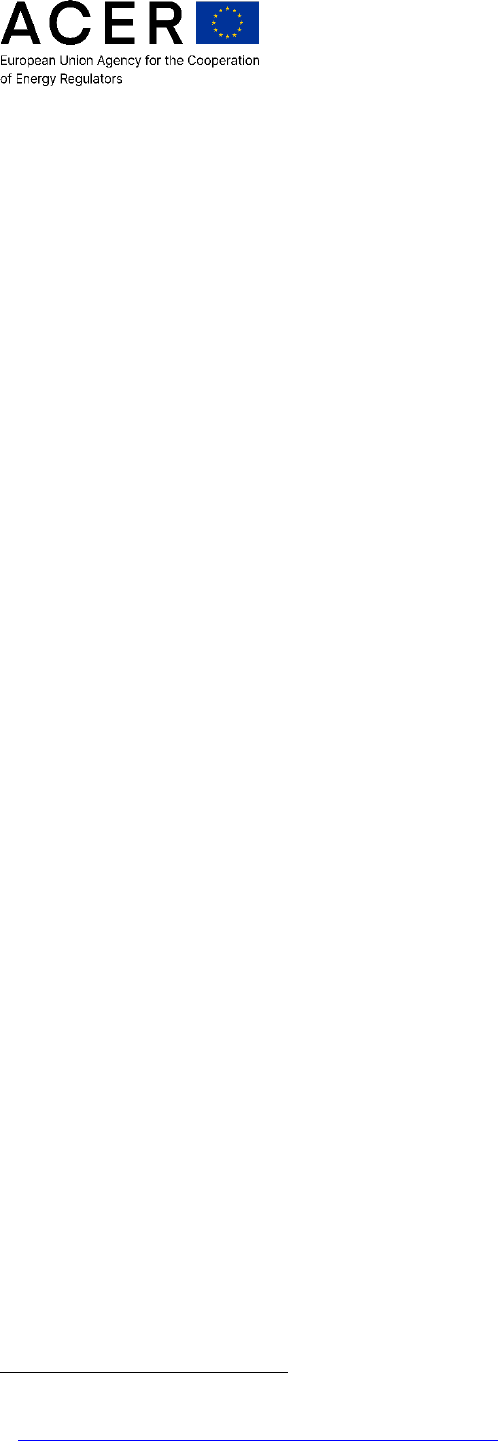
PUBLIC
Recommendation No 02/2023
Page 39 of 55
As stated in the Agency Position Paper “towards greater consistency of cost-benefit analysis
methodologies”
50
, an accurate assessment of certain indicators would require a detailed
modelling beyond the single sector approach, considering at least gas, hydrogen and the
electricity sectors. Such approach would allow to capture interactions among projects which
are not captured by common input data and common assumptions as well as limit the risk of
double counting the benefits.
Promoters having submitted an investment request, should indicate which CBA result (if any),
has been carried out considering an ‘interlinked’ approach. Project promoters should provide
all related assumptions and methods applied.
50
ACER_Consistency of CBA methodologies.pdf (europa.eu)

PUBLIC
Recommendation No 02/2023
Page 40 of 55
Annex I.2 – Project-specific Cost-Benefit Analysis – Electricity infrastructure
This section focuses in particular on the electricity project category as defined in Annex II(1)
of Regulation (EU) 2022/869, when under the competence of NRAs.
Future editions of this Agency Recommendation may include specific sections dedicated to
other project categories, for which, at the time of the drafting of this Recommendation, the
respective CBA methodologies were still under development.
The current ENTSO-E CBA methodology
51
includes a list of 8 benefit components
52
.
From this list, the Agency recommends that at least the following benefits are monetised and
separately presented:
a) socio-economic welfare (SEW) due to the following causes:
• SEW related to capacity increases on cross-border boundaries (calculated by a
European market study);
• SEW related to capacity increases on internal boundaries (calculated by a local
market study);
• SEW related to the benefits due to avoided re-dispatch or generation curtailments
beyond those captured by the market studies (calculated by network studies);
b) variation in losses (calculated by network studies);
c) security of supply (adequacy) (calculated by network studies).
In case of non-zero values for losses benefit, the assumption on the value of losses (€/MWh)
has to be indicated.
In case of non-zero values for Security of Supply (SoS) benefit, the assumption on the value
of lost load (€/MWh not supplied) has to be indicated.
Furthermore, market-study simulation tools should be able to identify the variation of SEW
benefit in each country. They should be designed to produce estimates of benefits for specific
stakeholder groups within a country (variation of producer surplus PS, variation of consumer
surplus CS and variation of congestion rents CR). In particular, the estimated variation of
congestion rents across each relevant border should be separately presented (i.e. no 50%-50%
allocation of CR variation to compute national benefits).
Network-study simulation tools should be able to identify the network busses where security
of supply is at risk, with potential Expected Energy Not Supplied (EENS), and to identify the
51
3rd ENTSO-E Guideline for Cost Benefit Analysis of Grid Development Projects- 27 October 2022.
52
Indicators B1-B9, except for indicator B3, the economic effects of which (in terms of variable generation costs
and CO2 emissions) are fully captured in indicators B1 and B2, respectively.

PUBLIC
Recommendation No 02/2023
Page 41 of 55
network elements (lines and transformers) where variations of losses take place with and
without the project under analysis. This would allow project promoters to provide country-
disaggregated values for SoS benefit and for losses benefit (only when such benefits are
significant).
The Agency recommends that every benefit component is disaggregated at national level for
each year of analysis. A higher level of disaggregation (PS, CS, CR) is required for the SEW
benefit.
Mitigation of negative externalities, such as loop flows, may not be regarded as cross-border
benefit
53
.
53
Article 16(6) of Regulation (EU) 2022/869.

PUBLIC
Recommendation No 02/2023
Page 42 of 55
Annex II – Calculation of national net impacts
This section explains how the elements pertaining costs and benefits should be considered
when calculating the countries net impacts.
• Costs
Description
Treatment for calculation of
national net impacts
Development costs (e.g. studies, rights of way, environmental
planning) and project management costs
Negative
Material and assembly cost, including installation and
commissioning
Negative
Other construction costs, including temporary solutions, waste
management and environmental costs
54
Negative
Consenting costs
55
Negative
Maintenance costs
Negative
Replacement costs during life cycle
Negative
Financing costs
Not to be counted
Cost for taxes
Not to be counted
Decommissioning costs where relevant
Negative
Cost of variation of losses
Already counted as benefit
• Benefits
Expected benefits, including losses variation, can differ between project categories. Benefits
should be counted as positive or negative (e.g. in case of a losses increase), depending on the
sign of their variation with and without the project.
54
Environmental costs are endogenous to the project. They may include costs for mitigating visual impact of
overhead lines and for landscape integration of power stations.
55
Consenting costs are exogenous to the project and may be incurred also shortly after commissioning of the
project. They may include dismantling costs of other infrastructures at the end of lifetime, compensation costs for
land use.

PUBLIC
Recommendation No 02/2023
Page 43 of 55
• Cross-border monetary flows
Description
Treatment for calculation of
national net impacts
Expected congestion rents for electricity PCIs/PMIs
Already counted in SEW
benefit
Expected revenues (payments) of ITC mechanism for
electricity PCIs/PMIs
Positive (negative)
Expected income (payments) for other charges
Positive (negative), if not
already counted
Awarded non-national grants
Positive
Awarded national grants
Not to be counted
Potential grants
Not to be counted
Expected revenues (payments) related to capacity bookings for
gas and hydrogen PCIs/PMIs
Positive (negative)
56
56
As long as effects related to revenues from capacity bookings are not already counted in the calculation of
benefits.

PUBLIC
Recommendation No 02/2023
Page 44 of 55
Annex III – Evaluation of impacts on network tariffs
The Agency recommends that the impact of the project implementation on network tariffs is
assessed in line with the relevant national regulatory framework and provided for each Member
State hosting the project and/or contributing to its financing.
In Members States where the tariff calculation is carried out by TSOs, NRAs are recommended
to i) evaluate that the project promoters’ tariff assessment is done in line with the regulatory
framework; ii) if appropriate, request clarifications or modifications in project promoters’
assumptions. In other cases, NRAs are recommended to directly assess tariff impacts.
In particular, the assessment of the impact on tariffs should comprise the following elements:
a) main characteristics of the applicable regulatory framework and how it applies to the
project under consideration;
b) main characteristics of the tariff methodology as applicable to electricity projects:
integrated tariff vs. network tariff, socialisation of costs in pursuit of lower network
tariff levels, etc.;
c) main characteristics of the tariff methodology as applicable to gas projects:
i. input to the methodology: does the methodology take into account existing
costs, or potential future costs (Long Run Marginal Costs)?;
ii. main cost allocation features: Entry-Exit split (revenue collected at entry points
compared to revenue collected at exit points), capacity commodity split
(revenue collected from charges applied to capacity, and revenue collected from
charges applied to commodity), level of multipliers (seasonal and daily
differentiation of the reserve price as compared to the annual reference price);
iii. main result of the cost allocation: domestic/cross-border split (revenue collected
from domestic points compared to revenue collected from interconnection
points).
d) estimated increase of allowed revenues:
i. eligible investment costs and operating costs.
57
ii. regulatory rate of return on assets: parameters and principles behind the
composition of the applicable regulatory rate of return.
e) in electricity, the effect of an investment on existing congestion rents or other charges,
revenues (i.e. sum of payments and receipts) stemming from the ITC mechanism
established under Article 49 of Regulation (EU) 2019/943. This comprises congestion
rents and its main assumptions in regards to the estimation and any obligatory use of
congestion rents as well as the time horizon assumed;
f) in gas, estimated revenues deriving from capacity bookings. Main assumptions with
regard to the estimation of revenues (e.g. capacity bookings from a market test,
57
Please see also Section 2.4 of this Recommendation. Note that, different from CBA, losses may be an operating
cost in some regulatory frameworks.

PUBLIC
Recommendation No 02/2023
Page 45 of 55
evaluation of commitments or expression of interest declared by market players, and
the respective regulated transmission tariff, as well as its calculation).
g) time horizon of the tariff impact calculation, which should include:
i. an explanation of the timing of the inclusion of allocated costs into tariffs, e.g.
at the time of occurrence or commissioning vs. disbursement over the lifetime
of an asset/regulatory period, any assumptions in regards to a potential time lag
for the revenues assumed and the reasoning, and
ii. an explanation of both the year-on-year annual tariff impact and the impact over
the entire assessment period. The assessment period is related to the regulatory
lifetime (depreciation) of the assets and the corresponding regulatory
remuneration. Depreciation methodology for different groups of assets should
be explicit and in line with the relevant national regulatory framework.
The Agency recommends that the tariff impact is presented both in relative terms (in %) and
in absolute terms (total variation per unit cost of transportation).
All allocated costs should be considered in the tariff assessment as the reference scenario.
Additionally, the effect of potential external funding (e.g. grants or other financial support) on
the estimated tariff impact can be presented for informative purposes. NRAs can indicate in
their cross-border cost allocation decisions the possible need for financial support for the
project to be implemented.
Any grants already received should be deducted from the investment costs to be considered in
the tariff calculations to make sure that any double counting or remuneration is avoided. All
the calculations should be presented both net of taxes and including taxes, where all the
components and applicable tax rates should be set out.
Tariff assessment should be focused on the incremental impact on network tariffs of the project
for which a request is submitted and which is subject of the cross-border cost allocation
decisions. The effect on network tariffs of infrastructure developments other than the one(s)
subject to the investment request should not be included in the tariff assessment of the project
subject of the investment request, but it may be presented as complementary information.
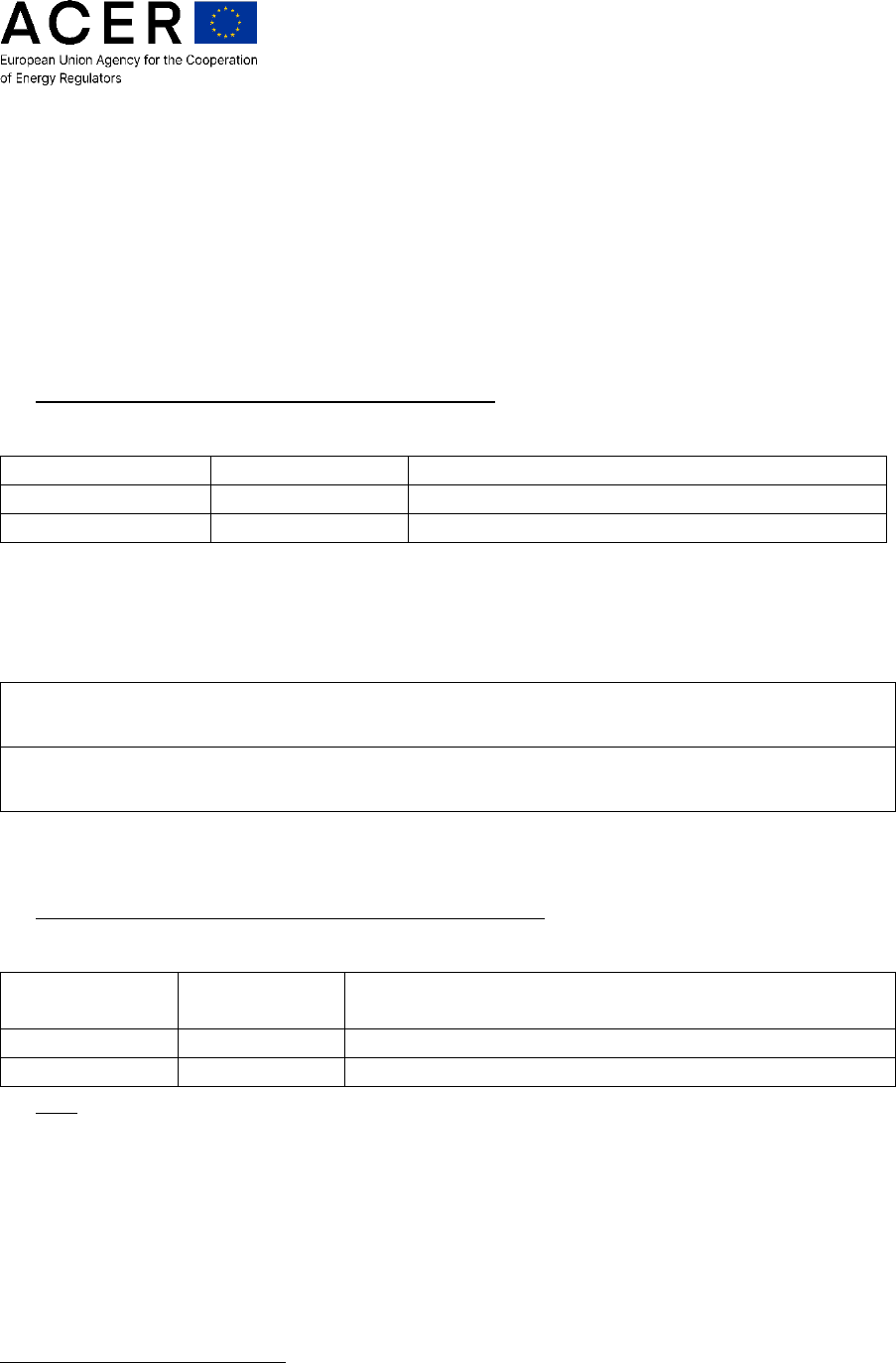
PUBLIC
Recommendation No 02/2023
Page 46 of 55
Annex IV – Summary data relevant for investment requests
58
The Agency recommends the filling of this template for each investment request (in English).
In case the investment requests concern multiple PCIs/PMIs, each PCI/PMI should submit a
separate investment request template for each project. All templates should be submitted to all
concerned NRAs.
Part I: projects subject of the investment request
Table-1
Project promoter
Project Name
Description of the project
In Table-2 below, please elaborate on the “significant” interdependencies of the projects
included in the submitted joint investment request (see Section 2.1 of this Recommendation).
Table-2
Reason for a joint investment request (in case of project clusters)
Part II: the project promoters and the consulted TSOs
Table-4
Project
promoter
Country
Address and contact details
• Note: insert all project promoters.
Table-5
58
Wherever possible, please provide numerical information in spread sheet format.

PUBLIC
Recommendation No 02/2023
Page 47 of 55
Consulted
TSO
Country
Date of submission of
all CBA data and
results
Date of feedback and
reasons for disagreement
(if any)
• Note: insert all TSOs with significant net positive impact (excluding project promoters).
Table-6
Consulted TSO
Country
Date of submission of
preliminary CBCA
proposal (if any)
Date of feedback and
reasons for disagreement (if
any)
• Note: insert all TSOs with significant net positive impact (excluding project promoters).
Part III: the concerned NRAs as identified by the project promoter(s)
Table-7
NRA
Country
Reasons for being concerned
(hosting the project / having significant net positive impact)
• Note: fill NRAs of countries of project promoters first and then other concerned countries, if any.

PUBLIC
Recommendation No 02/2023
Page 48 of 55
Part IV: the detailed implementation plan for the project
Table-8
Project step
(expected) start date
(expected) end date
“under consideration”
Planned but not yet in permitting
Preliminary design studies
Market test (for gas/hydrogen)
Preliminary investment decision
Public consultation process
Permit granting process
Financing
Cross border cost allocation
Exemption from third party access
Final investment decision
Detailed design
Tendering
Construction
Commissioning
Part V: scenarios for the assessment of project’s benefits
Table-9
Name of the
scenario
Assessed
Year(s)
Is it a TYNDP
scenario?
Weight
attached to the
scenario
Source of the
scenario and
relevant links
• Note1: insert rows as needed.
• Note2: under the column “Assessed Year(s)” please include all years assessed under that specific
scenario (e.g. 2030/2040/2050).
• Note3: under the column “Is it a TYNDP scenario?” please include (1) “Yes” if the same storyline
and data from a TYNDP scenario were used; (2) “No” if the scenario used is not a TYNDP scenario;
(3) “Partially” if the basis for the scenario used was a TYNDP scenario and the data have been
changed by the project promoters.
• Note4: under the column “Weight attached to the scenario” please include the “weight” attributed
to each scenario when computing the CBA benefits for the identification of each country overall
net impact.

PUBLIC
Recommendation No 02/2023
Page 49 of 55
For each non-TYNDP scenario
59
, please provide in Table-10 the description, the difficulties
and the reasons for not choosing the same TYNDP scenario as published by ENTSOG and
ENTSO-E.
Table-10
Name of the scenario
Description, difficulties, reasons for not choosing the
TYNDP scenario
Note: insert rows as needed
For each non-TYNDP scenario, please provide below the description of its compliance with
the following:
• Consistency with EU 2030 targets for energy and climate
• Consistency with 2050 climate neutrality objective
• Adequate level of consultation and scrutiny
• ACER Scenario Framework Guidelines
Table-11
Name of the scenario
Description of the scenario compliance with the elements
listed above
Note: insert rows as needed
Part VI: the project-specific cost benefit analysis
In case the investment request concerns a cluster of projects, please fill in all the tables of this
section related to costs and benefits, for the project cluster with and without each single
project included in the cluster, (by duplicating and filling in the different tables).
Part VI.1 – money, currency and discounting method
The discounting method is in line with the Agency’s Recommendation.
The monetary values are expressed in Euro, in constant (real) prices, and referred to the year
of the submission of the investment request.
(If applicable) the following assumptions about exchange rates are used: .
59
For non-TYNDP scenarios it is meant all scenarios for which project promoters have indicated “No” or
“Partially” in Table-9.

PUBLIC
Recommendation No 02/2023
Page 50 of 55
Table-12
Country and currency
Year(s)
Assumption on exchange rate vs. Euro
Note: insert rows as needed
Part VI.2 - COSTS - expected figures
In the tables below, please provide single values, expressed in Million Euro, in constant (real)
prices, referred to the year of the submission of the investment request.
In case the project realisation foresees costs in more than one country, duplicate the table and
fill in a table for each of the concerned countries.
Values in Table-13 and Table-14 should be discounted (see Annex I of this Recommendation)
Table-13
Country
add country name
Present value of costs [MEuro]
Cost component
Before commissioning
After commissioning
Development costs
Project management costs
Materials and assembly costs
Temporary solutions
Environmental costs
Consenting costs
Sub-total (investment costs)
Maintenance
Replacement of devices
Decommissioning
Total
Table-14
Country
add country name
Expected costs
variations
Value of costs
[MEuro]
Downward
variation [%]
Upward
variation [%]
Reason(s)
Being a disaggregation of the costs across the years, the values in Table-15 below should be
provided as non-discounted.

PUBLIC
Recommendation No 02/2023
Page 51 of 55
Table-15
Country
add country name
Yearly disaggregation of costs
before commissioning [MEuro]
Year:
Year:
Year:
Year:
Year:
Total
Part VI.3e - BENEFITS (electricity) - expected figures
In Table-16, please provide single values, expressed in Million Euro, in constant (real) prices,
referred to the year of the submission of the investment request. Values should be discounted.
Please fill in one table for each scenario considered and for each impacted country (duplicate
and fill as many tables as needed).
Please fill VI.4 below for ranges and variations.
Table-16
Scenario
add scenario name
Country
add country name
Benefit type
Present value of net
60
benefits
[MEuro]
Benefit component
SEW (EU-wide market study) – producer surplus
SEW (EU-wide market study) – consumer surplus
SEW (EU-wide market study) – congestion rent
National constraints (SEW local study)
Sustainability (global benefits)
Sustainability (local benefits)
Variation of generation curtailments
Variation in losses
Security of supply (load)
Other benefits
Total
60
For “net benefit” it is always meant the sum of positive and negative effects.
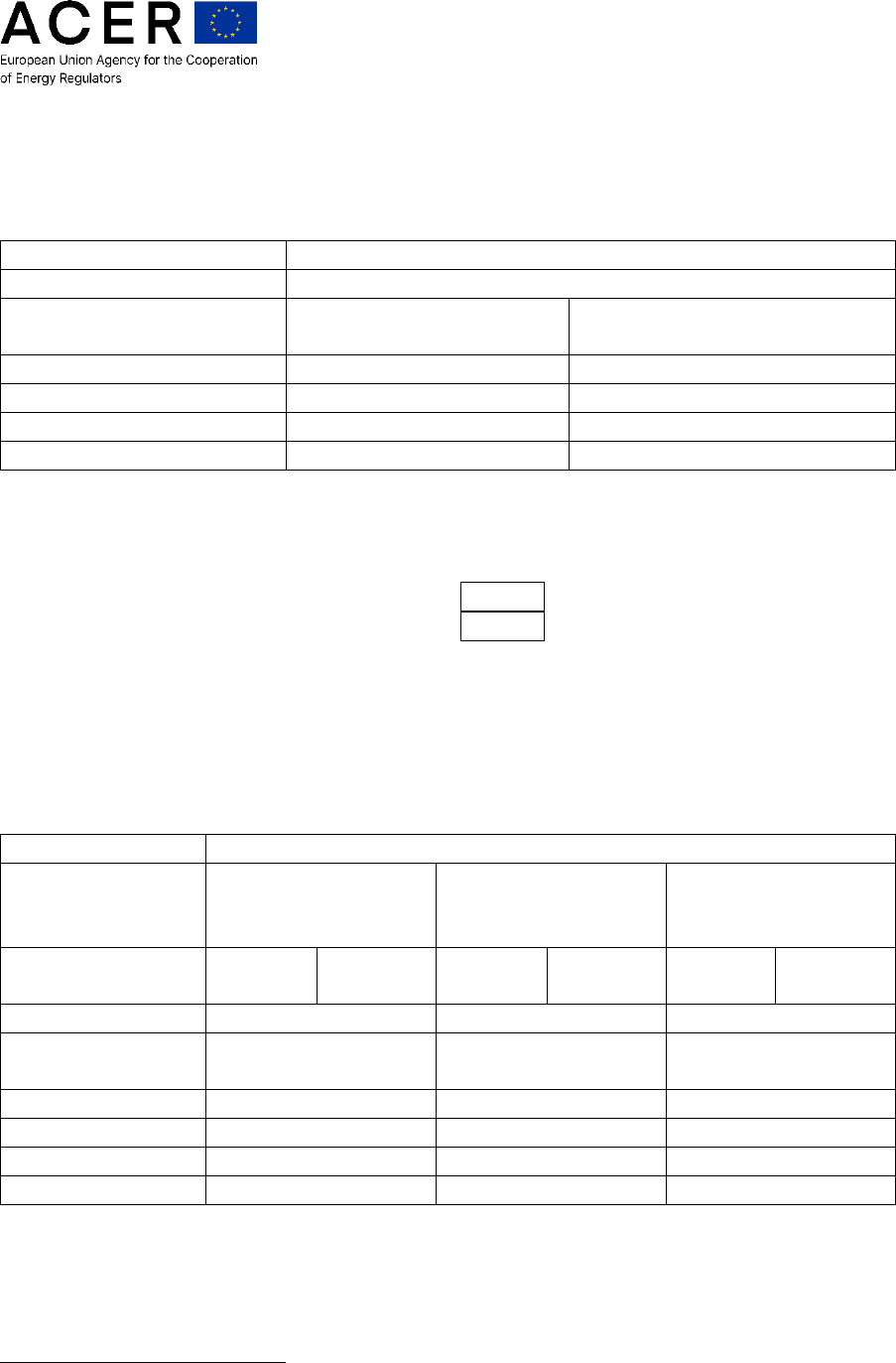
PUBLIC
Recommendation No 02/2023
Page 52 of 55
Given the value of congestion rent provided in Table-16 as part of the SEW, please indicate in
Table-17 the assumed share of congestion rent and relative discounted value.
Table-17
Scenario
add scenario name
Country
add country name
Congestion rent at
relevant border
Congestion rent sharing
Present variation of net
61
congestion rent [MEuro]
Border:
please specify X:Y
Border:
Border:
Border:
The other benefits indicated (if applicable) correspond to these benefit components in the
Agency’s Position on the ENTSO-E ‘Guideline to Cost Benefit Analysis of Grid Development
Projects’:
• The value of losses (if applicable) is [MEuro]
• The value of lost load (if applicable) is [MEuro]
In Table-18, fill in the year of the assessment for short-term / mid-term / long-term periods in
the dedicated space and the benefits in MEuro assessed in that specific assessment year. Since
referring to a specific assessment year, the values for both producer surplus and consumer
surplus in Table-18 should be non-discounted and non-interpolated.
Table-18
Scenario
add scenario name
Short-term period:
Year ____
[MEuro/year]
Mid-term period:
Year ____
[MEuro/year]
Long-term period:
Year ____
[MEuro/year]
Benefit component
Producer
surplus
Consumer
surplus
Producer
surplus
Consumer
surplus
Producer
surplus
Consumer
surplus
SEW (EU-wide)
National
constraints
G curtailments
Variation in losses
Security of supply
Other benefits
61
For “net benefit” it is always meant the sum of positive and negative effects.
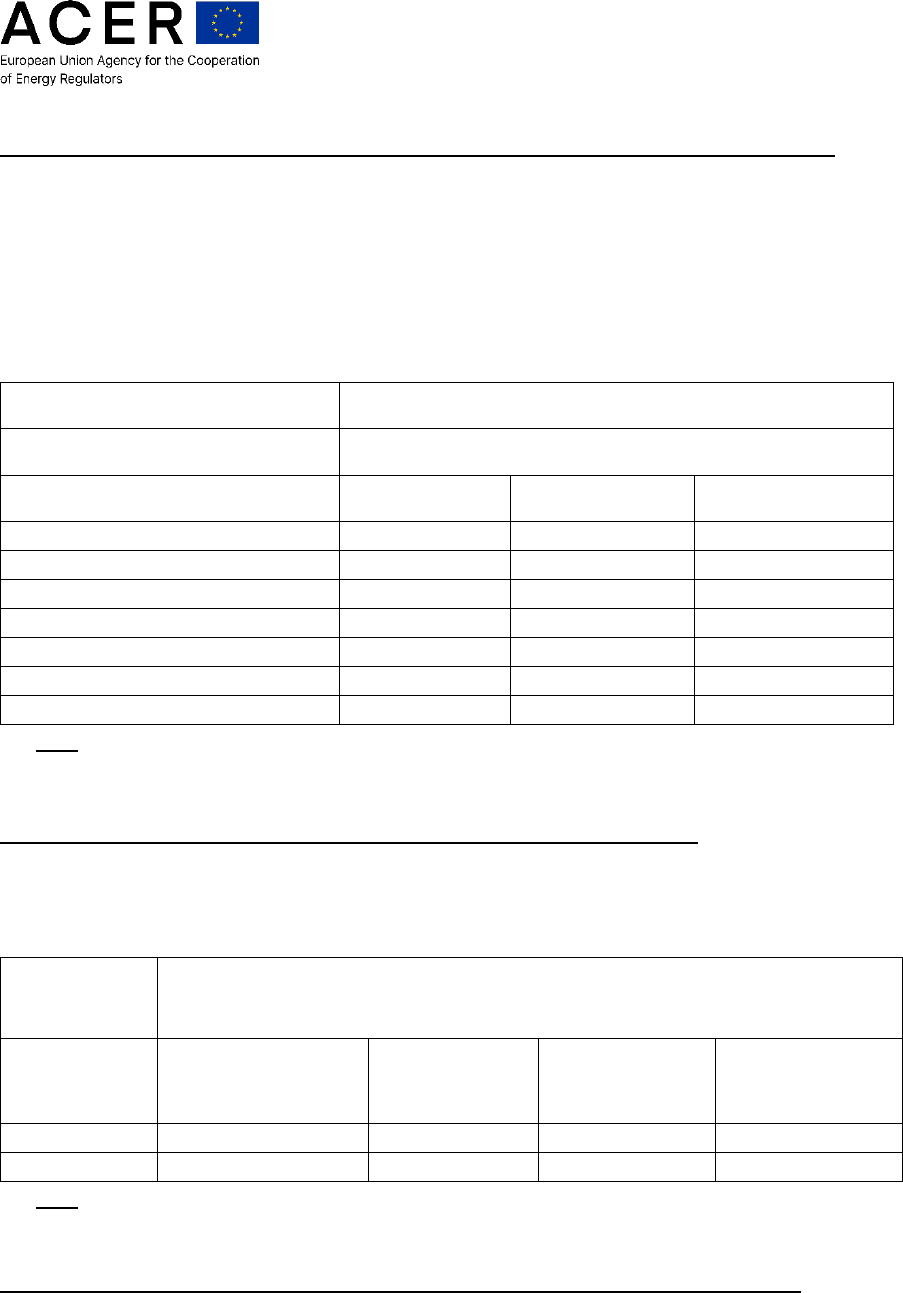
PUBLIC
Recommendation No 02/2023
Page 53 of 55
Part VI.3o - BENEFITS (other project categories than electricity) - expected figures
In Table-19, please provide single values, expressed in Million Euro, in constant (real) prices,
referred to the year of the submission of the investment request. Values should be discounted.
Please fill in one table for each scenario considered (duplicate and fill as many tables as
needed). Please indicate in the columns “Country” the name of the impacted country.
Please fill VI.4 below for ranges and variations.
Table-19
Scenario
add scenario name
Present value of net
62
benefits [MEuro]
Benefit component
Country 1
Country 2
Country 3
Market integration
Competition
Security of supply and flexibility
Sustainability (global)
Sustainability (local)
Other benefits (to be justified)
Total
• Note: insert columns as needed.
Part VI.4 - BENEFITS - expected variations (for all project categories)
Please fill in one table for each scenario considered.
Table-20
Scenario
add scenario name
Country
Total present
value of net
63
benefits [MEuro]
Downward
variation [%]
Upward
variation [%]
Reason(s)
• Note: insert rows as needed.
Part VI.5: other cross-border monetary flows (revenues, ITC, other charges, grants)
In Table-21, please provide single values, expressed in Million Euro, in constant (real) prices,
referred to the year of the submission of the investment request. Values should be discounted.
Please fill in one table for each scenario considered (duplicate and fill as many tables as
needed). Please indicate in the first columns “Country” the name of the impacted countries.

PUBLIC
Recommendation No 02/2023
Page 54 of 55
Table-21
Scenario
add scenario name
ITC (electricity)
Present value of net
64
ITC impact [MEuro]
Country 1
…
Note: please specify whether net revenues or net payments.
Table-22
Scenario
add scenario name
Market test results
(gas/hydrogen)
Present value of expected revenues from network users’
long-term commitments (regulated tariff + share of
potential auction premium due potential congestions)
[MEuro]
Country 1
…
Note: please specify whether net revenues or net payment.
Table-23
Scenario
add scenario name
Description of other
charges
Country
Present value amount
[MEuro]
Note: please specify whether net revenues or net payment.
Table-24
Scenario
add scenario name
Country
add country name, if relevant
Description of
grants (national /
international)
Status (awarded and received /
awarded and still to be
received / requested / potential
future request)
Present value of the amount
granted [MEuro]
62
For “net benefit” it is always meant the sum of positive and negative effects.
63
For “net benefit” it is always meant the sum of positive and negative effects.
64
For “net benefit” it is always meant the sum of positive and negative effects.
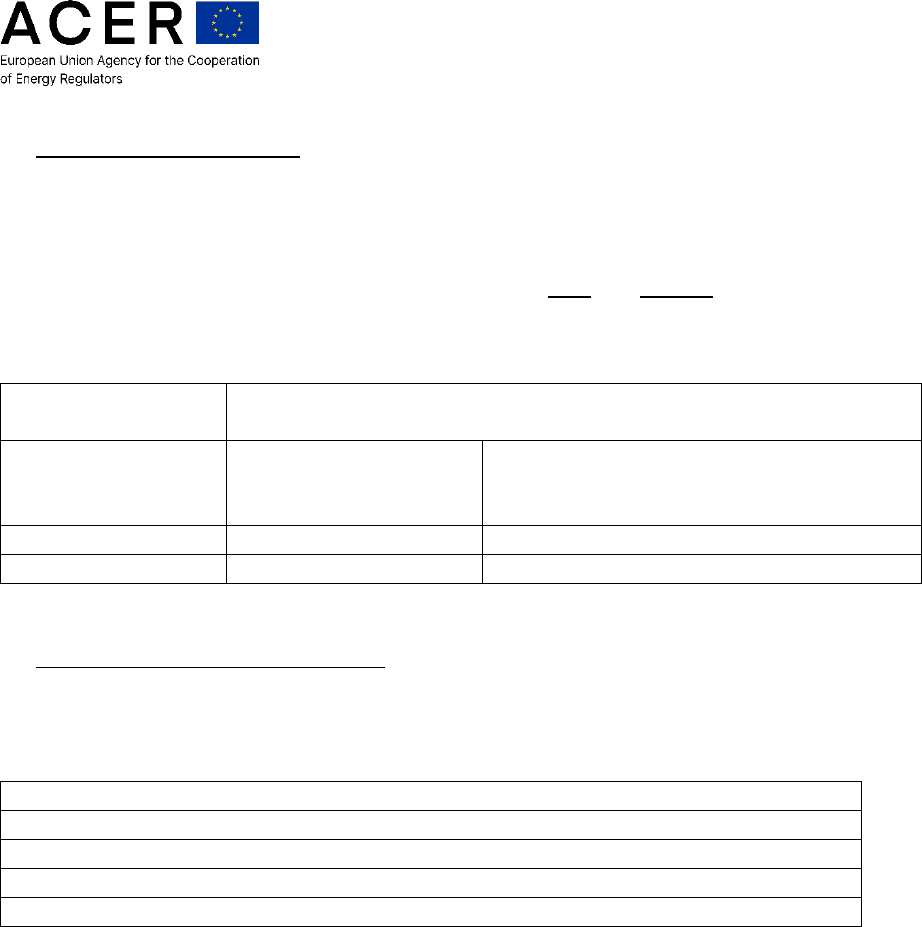
PUBLIC
Recommendation No 02/2023
Page 55 of 55
Part VII: overall net impact
Based on the information provided in Part V and Part VI, please indicate in Table-25 below
the resulting overall net-impact for each impacted country.
In case the investment request concerns a cluster of projects, indicate below the net impacts,
which is created by the realisation of the project cluster with and without each single project
included in the cluster (by duplicating and filling in the different tables).
Table-25
Description:
Describe whether the table refers to the whole project cluster or to
the project cluster without project XYZ
Country
Indicate if the country
is “Hosting” or “Non-
hosting” the project
Present value of overall net impacts
(positive / negative) [MEuro]
Part VIII: accompanying documents
Please include in Table-26 number, scope and title of every accompanying document.
Table-26
